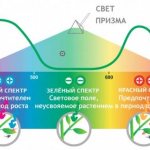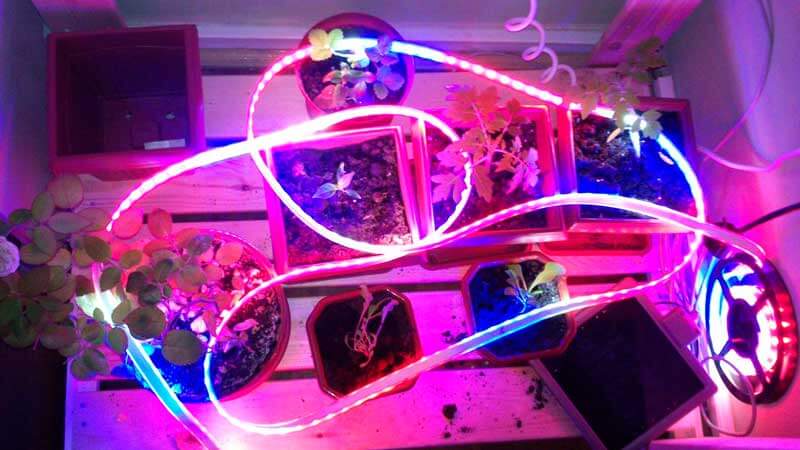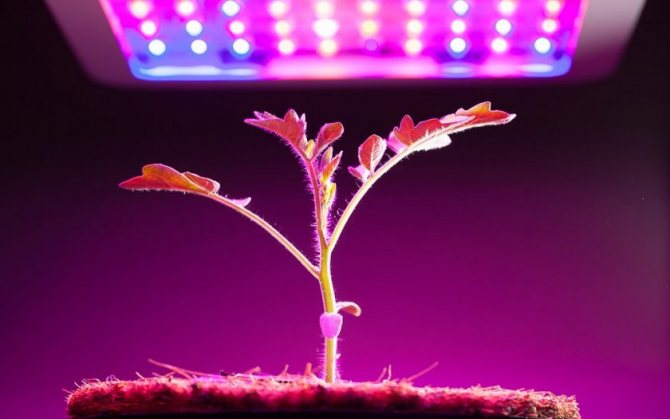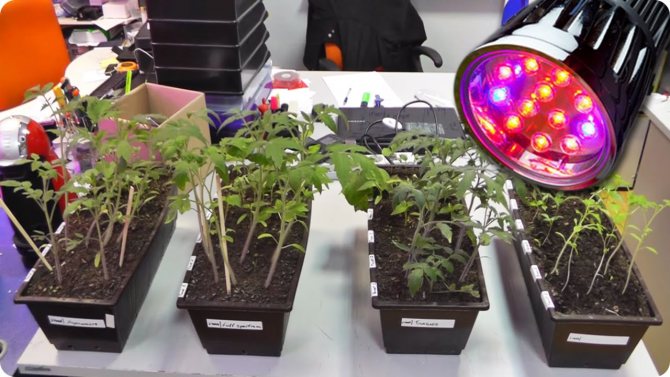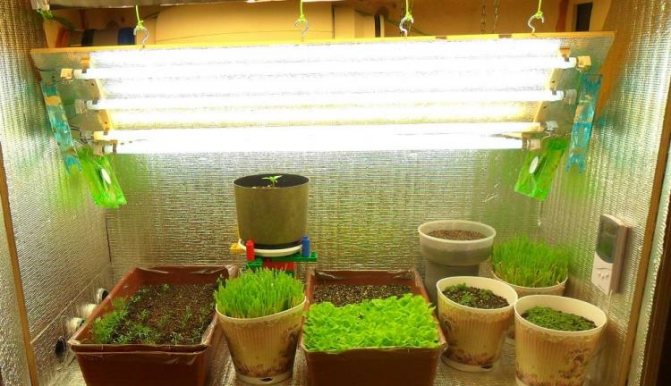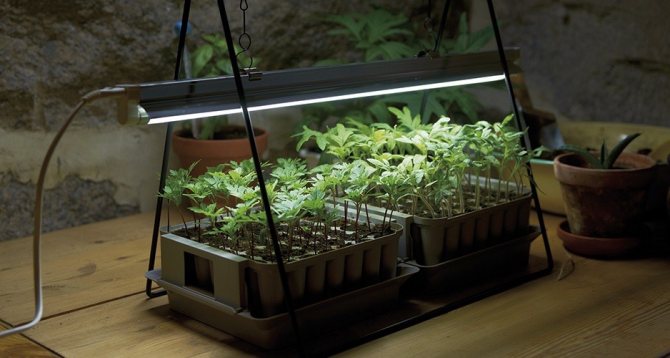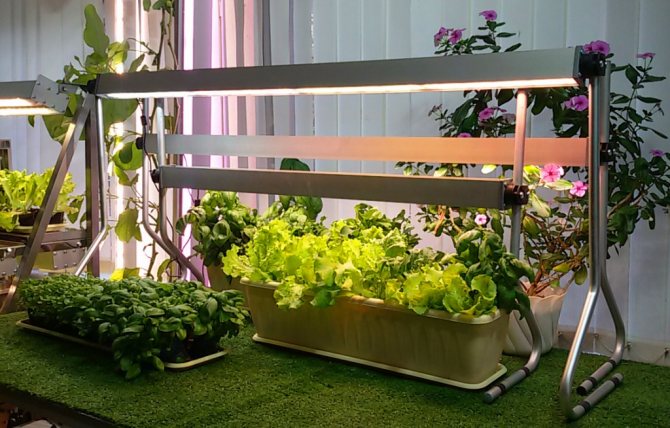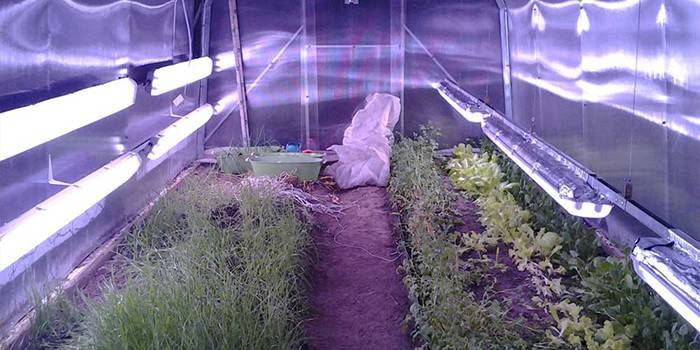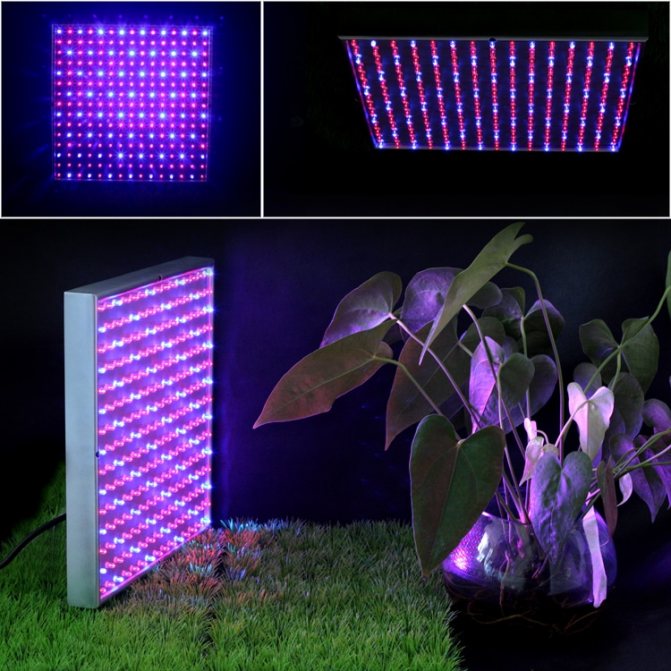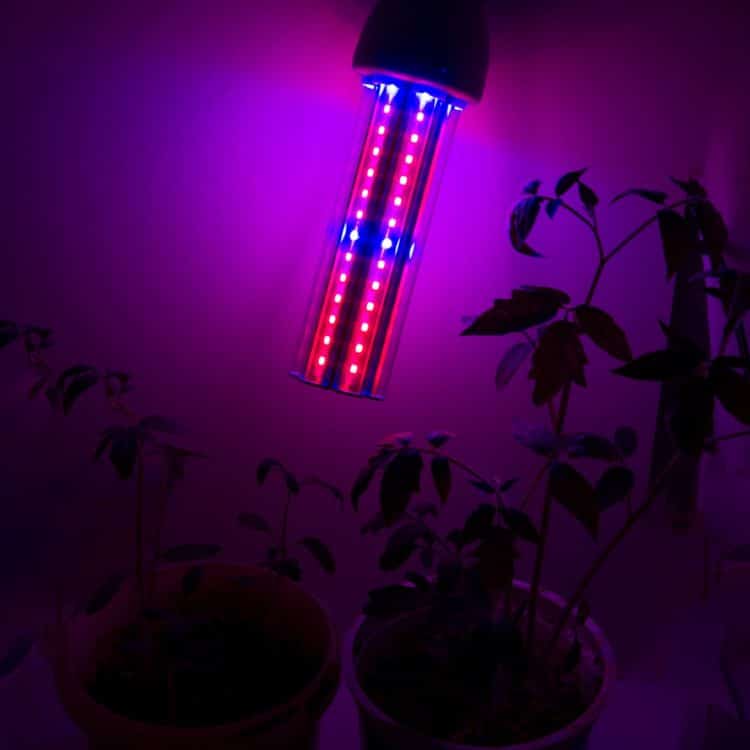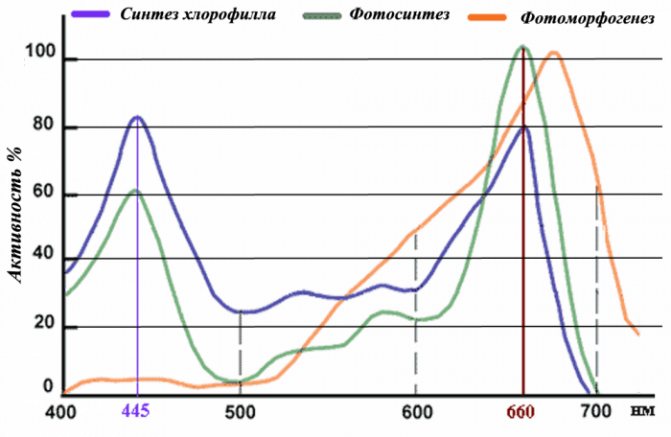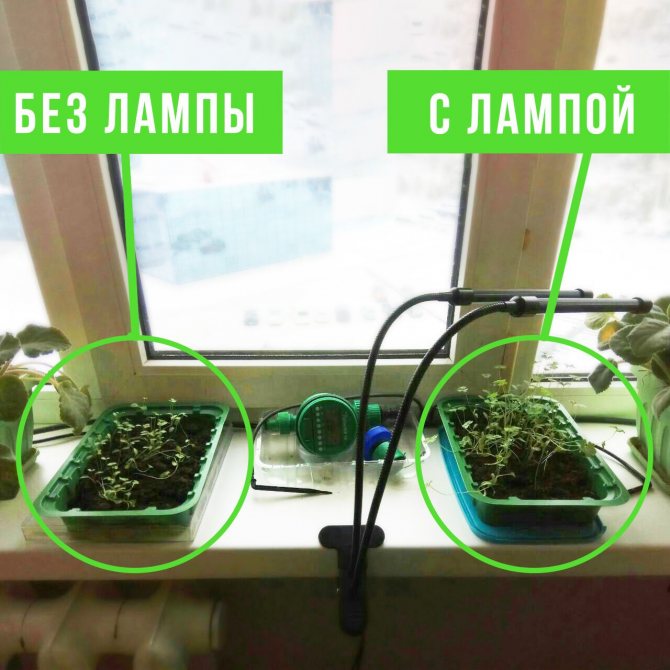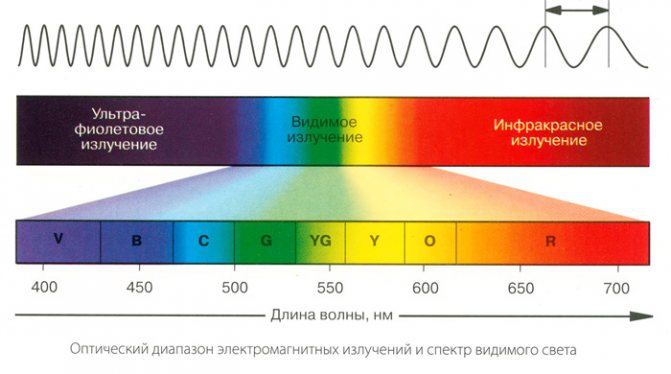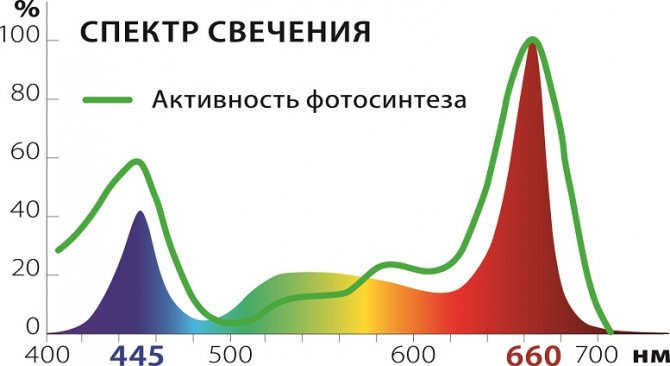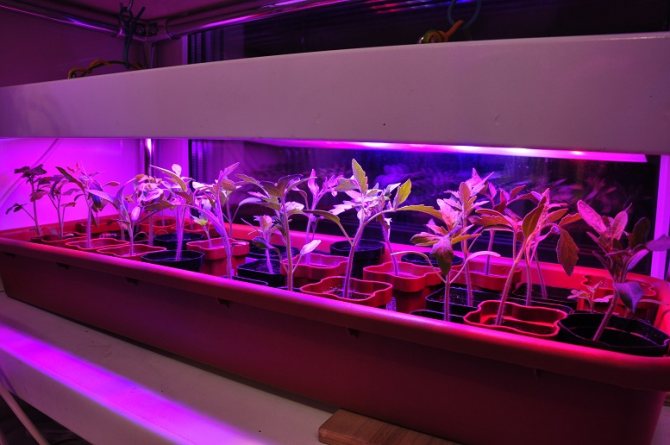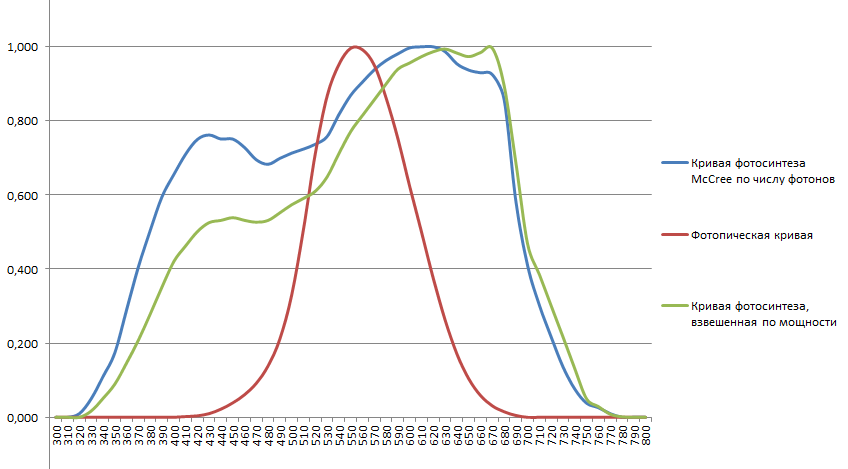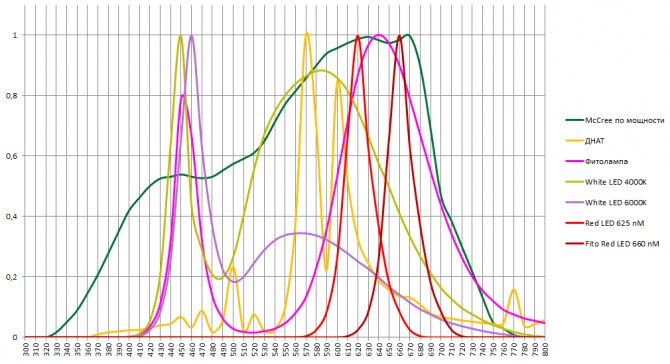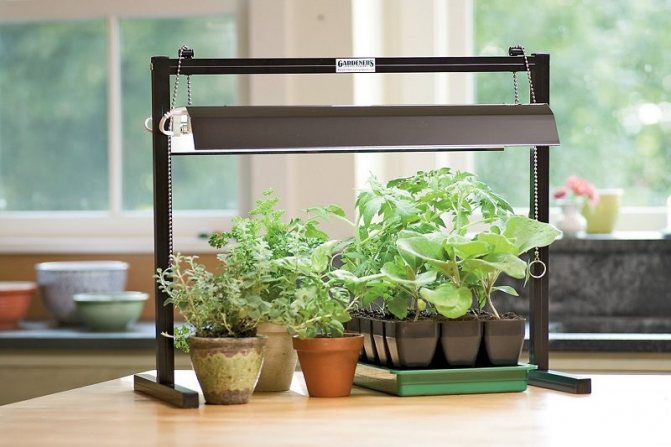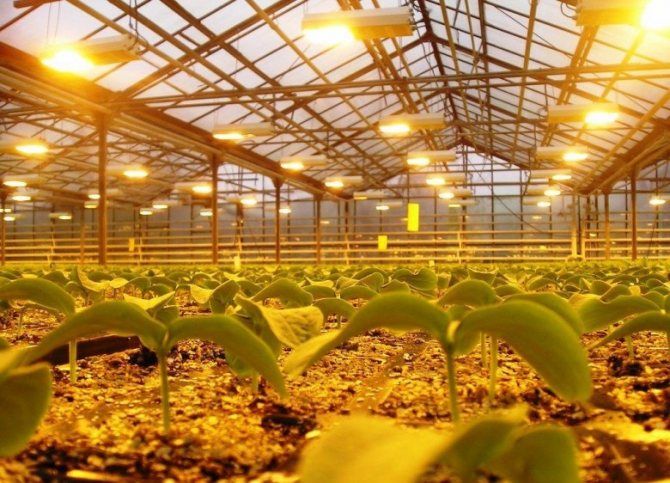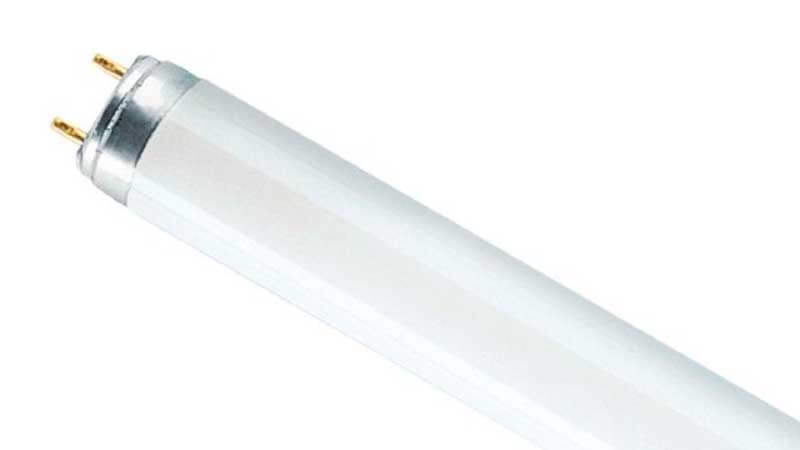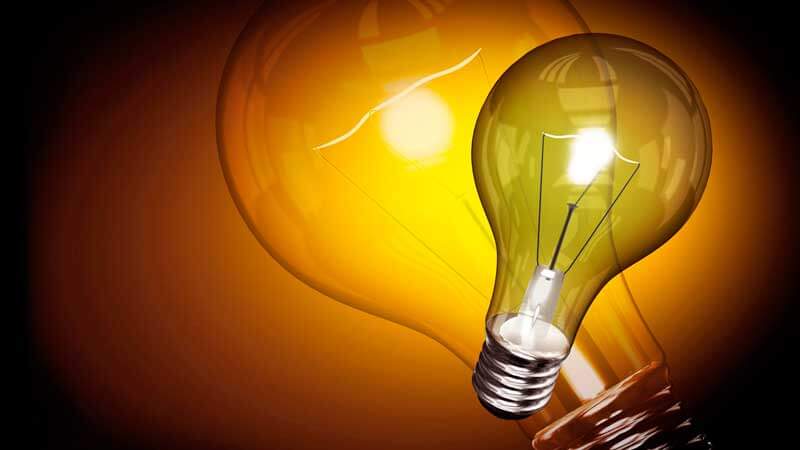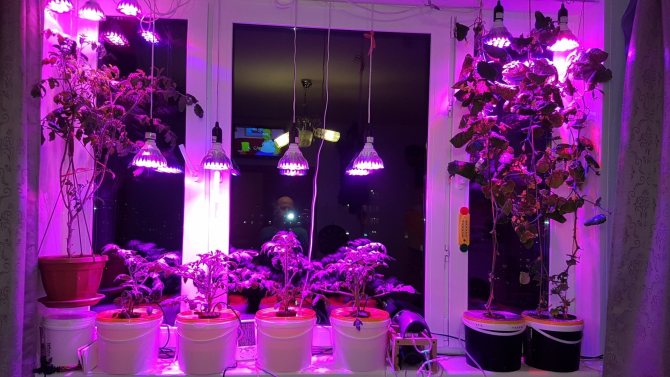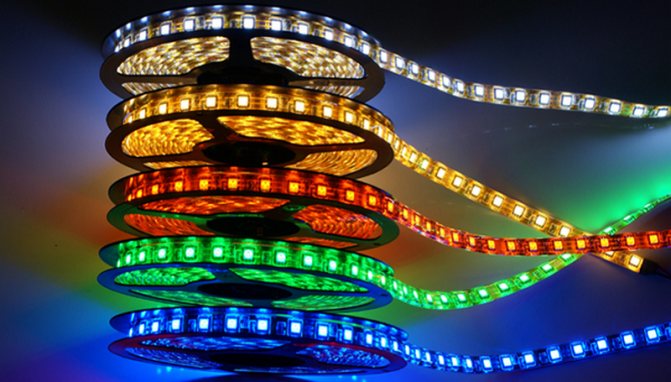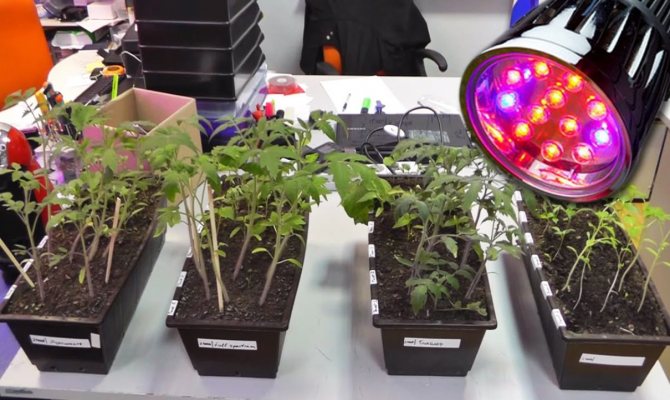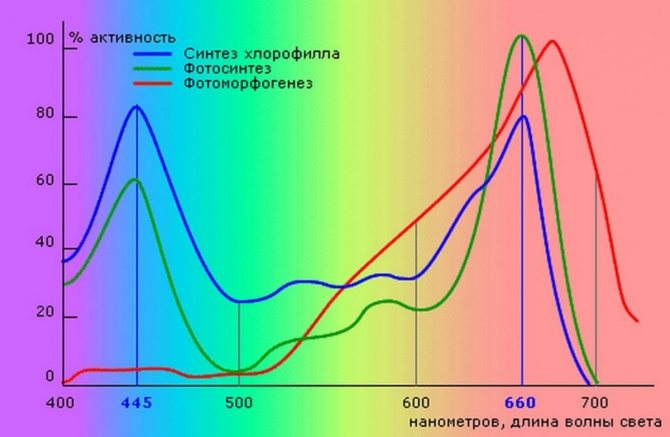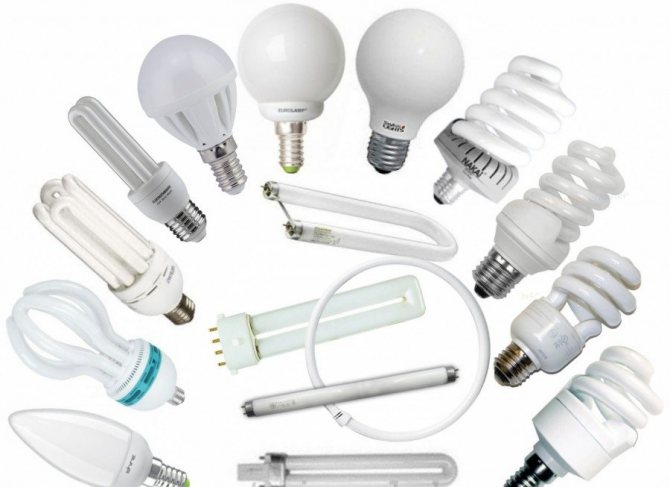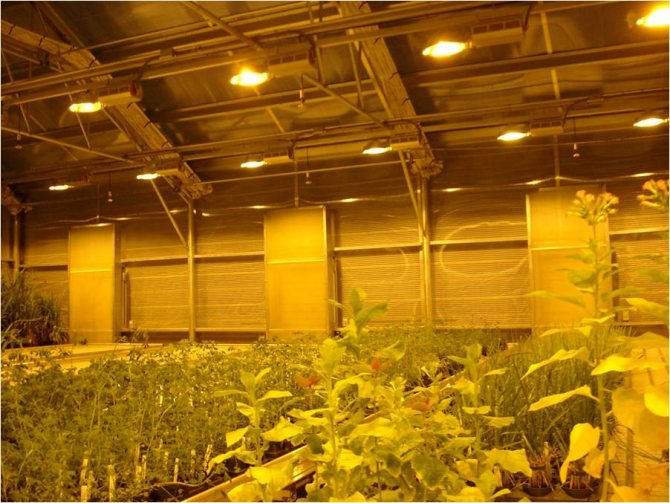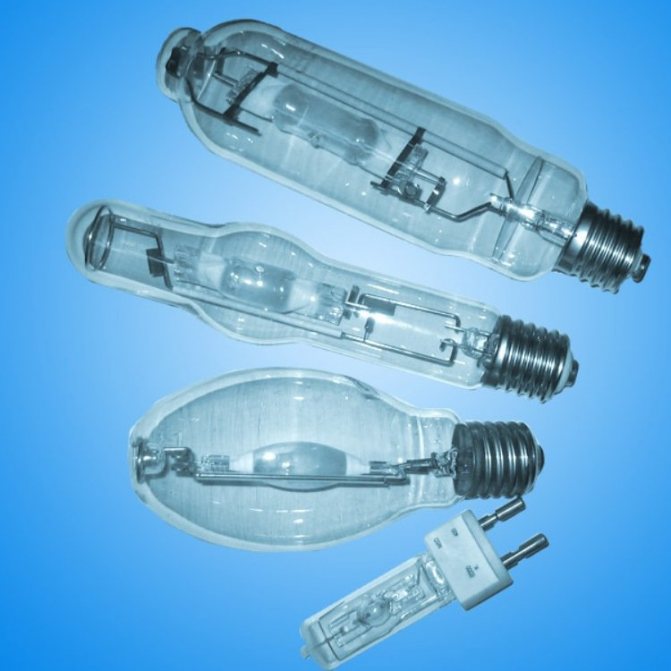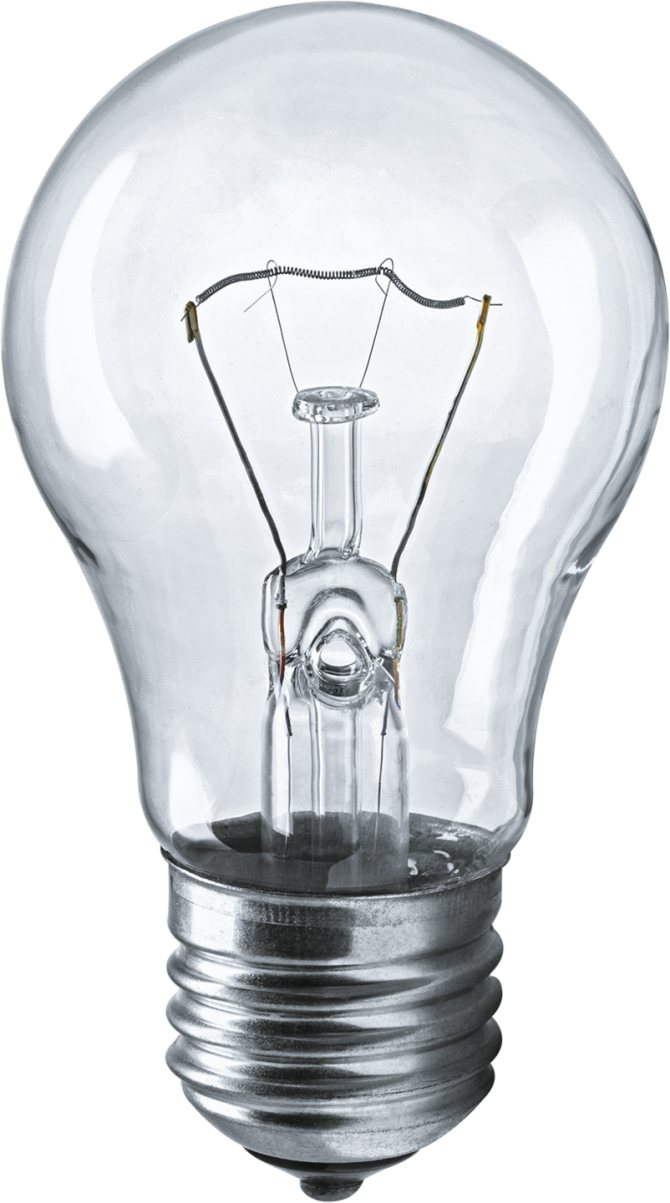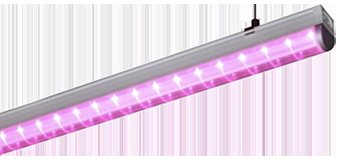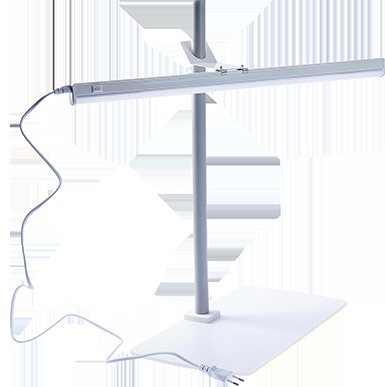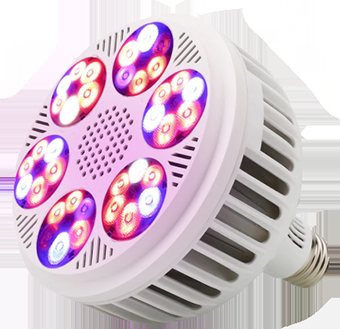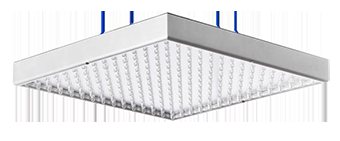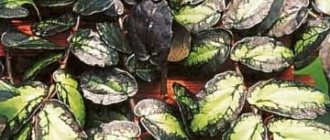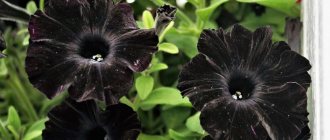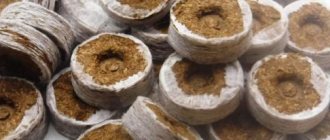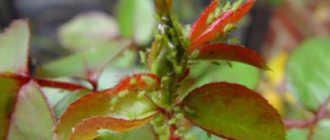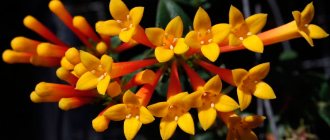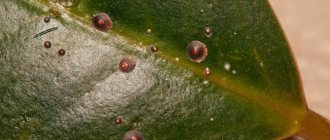Every experienced florist knows what a huge role the right lighting for indoor plants plays. Along with watering and soil, light is an indispensable component on which successful growth directly depends. It is no secret that in the natural environment, some plants thrive in shaded areas, while others cannot develop without direct exposure to sunlight. At home, the situation looks similar. We will talk in detail about how to correctly make artificial lighting for indoor plants.
Decorative and plant growth lighting
A bulb for growing indoor plants is a great way to extend daylight hours. After all, many indoor flowers are of tropical origin, which means that they experience a lack of solar energy every day, especially in winter. For effective plant growth, the duration of daylight hours should be about 15 hours. Otherwise, they weaken, stop blooming and are exposed to various diseases.
When planning the future illumination of indoor flowers, it is important not to miss out on the aesthetic component. The phyto-lamp should become a part of the interior, a kind of decor element. On sale there are a huge number of wall-mounted luminaires of various shapes, for any energy-saving lamp: CFL or LED. Depending on the size of the home flower garden, the backlight can be made from several spot lamps aimed directly at each green pet, or from tubular fluorescent lamps with a reflector. By connecting your own imagination, you can make an original LED phyto-lamp yourself.
Distinguish between real and nominal diode power
Diodes come in different wattage - 1 W, 3 W or 5 W. For the needs of the "home greenhouse" the most suitable are emitter lamps with a primary lens, which scatter light at an angle of 120 degrees. A 3 W lamp with the correct ratio of emitted light and heat is considered optimal.
In order not to be mistaken with the choice of a lamp, it is necessary to distinguish between the concepts of nominal and real power. Let's figure out what they mean. The rated power is the power at which the diode operates at its maximum limit. This means that the "life" of the diode under such a load will be short. To make the diodes last longer, they are "fed" by half of their power, that is, a 3 W diode will in reality "show" 1.5 watts. This is its real power. Self-respecting manufacturers of LED lamps are required to indicate this information on their websites (see Figure 2).
The most important component of growth is the light spectrum
In order to understand how heterogeneous the light from different electrical sources and the sun is, it is necessary to look at their spectral composition. The spectral characteristic is the dependence of the radiation intensity on the wavelength. The solar radiation curve is continuous over the entire visible range with a decrease in the UV and IR regions. The spectrum of artificial light sources in most cases is represented by individual impulses of different amplitudes, which as a result gives the light a certain shade.
During the experiments, it was found that for the successful development of plants, not the full spectrum is used, but only its individual parts.The following wavelengths are considered the most vital:
- 640–660 nm - a velvety red color, necessary for all adult plants for reproductive development, as well as for strengthening the root system;
- 595-610 nm - orange for flowering and ripening of fruits;
- 440–445 nm - violet for vegetative development;
- 380-400 nm - near UV range to regulate the growth rate and protein formation;
- 280-315 nm - mid-UV range to increase frost resistance.
Illumination with only the listed rays is not suitable for all plants. Each representative of the flora is unique in its “wave” preferences. This means that it is impossible to fully replace the energy of the sun with the help of lamps. But artificial lighting of plants in the morning and evening hours can significantly improve their life.
What spectrum of phytolamp should be
If we talk about general division, then range of phytolamps for plants may be:
- Blue. Seedlings and very young flowers will like it. Their main purpose is to give impetus to the development of leaves.
- Red. There is already an influence on the roots, buds and fruits.
- Purple. This one is good for young shoots. In his arsenal and the ability to influence growth and development.
- White. In fact, it is not white, it is people used to call it that, because it is impossible to distinguish with the naked eye that this complex spectrum consists of the first two shades, as well as green and yellow. True, with such a glow, part of the energy goes nowhere, because the plant uses only the rays it needs.
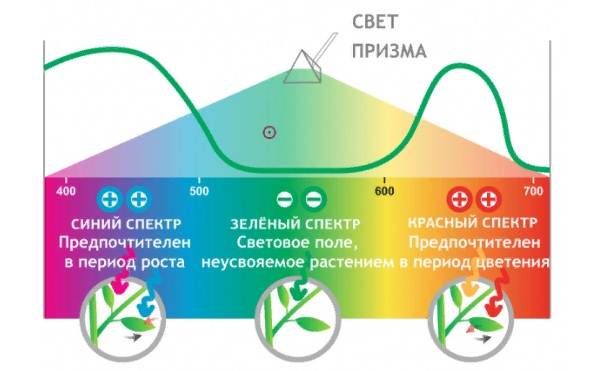
Signs of a lack of light
There are a number of signs by which it is easy to identify a lack of light. You just need to take a close look at your flower and compare it with the standard. For example, find a similar look on the Internet. A clear lack of illumination is manifested as follows. The plant slows down its growth. The new leaves are smaller and the stem becomes thinner. The lower leaves turn yellow. The flower either stops blooming completely, or the number of buds formed is less than the average. At the same time, it is considered that watering, humidity and air temperature are normal.
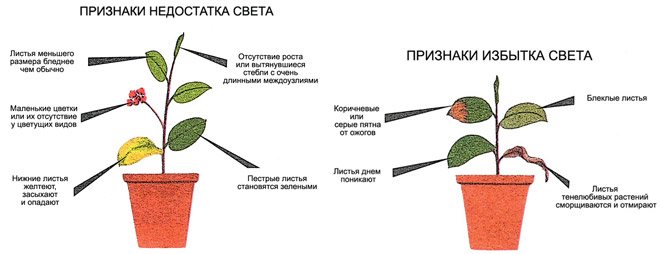

Consider installing additional lenses
As mentioned earlier, the diodes already have a primary lens and a 120 degree exposure angle. But if you hang the lamp too high, less light will reach the plants, and it will be more scattered. That is, the light will cover a non-useful area. Such use is ineffective, but you will have to pay extra for electricity. Installing additional lenses will help solve this problem. They are 15, 30, 45, 60, 90 degrees. Fitting a lens will make it possible to select the desired height and maintain the useful lamp power required by the plants.
How much light do you need?
It is impossible to give an unambiguous answer to this question. As a person can live in different parts of the globe, so an indoor flower can grow on a windowsill with access to the north, south, west or east. The plant throughout its life will strive to adapt to the current conditions: to stretch upward from a lack of illumination, or, conversely, to expose the next blossoming bud to the sun's rays.
By observing the appearance of the stems and leaves, the size and number of flowers, it is possible to determine the sufficiency of the lighting level. At the same time, do not forget about what stage of development the indoor flower is at: vegetation, flowering, seed ripening. At each of the stages, he takes from the sun the light of the wavelength that he needs at the moment. Therefore, when organizing additional lighting, it is important to take into account the quality component of the luminous flux.
Prolonged exposure to the bright light of the sun and lamps with an illumination level of more than 15 thousand lux are loved by those indoor flowers that grow in their natural habitat in the open air. This is a favorite of many Crassula, geranium, Kalanchoe, begonia. Artificial lighting for plants of this type in the evening will benefit them.
Representatives of the flora that feel comfortable under illumination of 10-15 thousand lux include spathiphyllum, clivia, saintpaulia, tradescantia and dracaena. The leaves of these types of indoor flowers do not like hot sunlight, but they also do not tolerate early twilight. Therefore, the ideal place for them would be a window sill with an exit to the west, where in the evening their leaves will receive the necessary energy from the setting sun.
The so-called shade-loving plants can bloom and develop far from the window opening, being content with illumination up to 10 thousand lux. However, this does not mean that they will die if they are placed in a brighter place. They just need less direct sunlight. These include some types of ficus and dracaena, philodendron, and tropical vines.
Calculate the power of the LEDs in the lamp correctly
How to calculate the total power of the LEDs? How many diodes should there be in a lamp? The answer to these questions depends on your specific situation. The most important thing in the choice is the ratio between the diode and the radiator (more on this in point 6).
The formula for calculating the number of diodes is pretty simple: M=TO×M1where M - total lamp power (W), TO - the number of diodes, and M1 - the power of one diode. However, not all manufacturers are extremely honest with their customers. In order not to fall for the bait, we close the knowledge gap.
Let's say you chose a 54W lamp with 18 diodes from Aliexpress, where the manufacturer claims that the power of each diode is 3W. If you measure it with a wattmeter (a device for measuring the power of connected devices), it turns out that it produces 11 watts.
It must be borne in mind that the diode cannot work at maximum for a long time! So, let's count: we divide 54 W by 18 diodes, we get 3 W for each diode, which work at full! But this cannot be! However, you pay for 54 watts of nominal power and 27 watts of real power (see information above.) But in fact, it gives out 11.6 watts. That's far from 27 watts.
The real output of the diode is half the power. Then if we take 1.5 W of the power of each diode and multiply by 18 diodes, we get that this lamp should consist of at least 27 diodes, and not 18, as it is in fact. Cheating? No, it's just that there are diodes of lower power, that is, with a power of 1 W, which work half of their power. Manufacturers, of course, do not write about this.
But how did it come about? We take 11.6 watts of real power from the outlet, divide by 18 diodes. And we get 0.64 watts! That is, 0.64 W is just about half of 1 W.
Now we take the lamp Minifermer.ru. The package says that the lamp consists of 12 diodes with a power of 3 W - in total, this is 36 W, that is, the real power from the outlet should be 15-18 W. And there is!
This means that there are exactly 3-watt diodes in the lamp! They will work for a long time, and you will get good results. So in the information for the lamp, both the nominal power and the real one must be indicated.
Supplementary lighting of plants and artificial light sources
In most cases, indoor plants need additional lighting. Flowers, which at first glance have bright green succulent leaves and bloom regularly, will look even better if you begin to influence them with a phytolamp. If someone thinks otherwise, then he has a great chance to be convinced of the erroneousness of his thinking and to assemble a phyto-lamp with his own hands. Various artificial light sources are used to extend daylight hours. Let's take a look at each of them and figure out which light is best for plants.
Incandescent lamps
Illuminating plants with incandescent bulbs is the least effective for several reasons. The radiation spectrum of ordinary bulbs with a spiral is strongly shifted to the red region, which does not contribute to photosynthesis in any way. Low efficiency and, as a consequence, huge heat release drive their energy and luminous efficiency to zero.In addition, incandescent lamps are characterized by the shortest service life in comparison with other artificial light sources.
Fluorescent lamps
Tubular fluorescent or, as they are most often called, energy-saving full-spectrum T8 daylight lamps (T = 5300–6500 ° K) have been considered the best option for illuminating indoor plants for many years. They have earned a lot of positive reviews due to their selective spectrum, economy and low heat dissipation, combined with an acceptable cost.
Types and characteristics
It would seem that it is just a lamp, but there can be a great variety of different characteristics indicated on its packaging. And each such inscription should be carefully looked at, otherwise the purchase will be useless. So, the box may be marked (a):
- Terms of operation (shelf life)
- Power indicators (here the spread is very large: from twenty to three hundred watts)
- Color temperature characteristic
- How economical is the device
- Light flow
The last indicator is key. It should become your main reference point. With its help, you will understand how much light is coming out in each direction. When you are looking for a device not for a greenhouse, but for an apartment, then, of course, external features will play an important role. Do not get too carried away with design, a beautiful form will not help business.
But the method of fastening is important. It can be a stationary object that needs to be installed in one place and secured. Or there is a variation of the pendant type. This structure can be moved if necessary. Today, several types of such devices are known:
1. Luminescent. Their color is lilac. Those. it turns out that there is an abundance of blue spectrum here, but very little red. Such conditions are the same only for picky shoots. Vegetable, herbs can still put up with such a neighborhood. More capricious - require other characteristics.
Not very useful for the human eye. Long-term viewing of such a picture may even cause a migraine. You won't have to spend a lot on them, but the service life leaves much to be desired. Plus, the power of light here is modest, so you often have to take paired ones. In the cold, you won't have problems with them, they may simply not turn on.
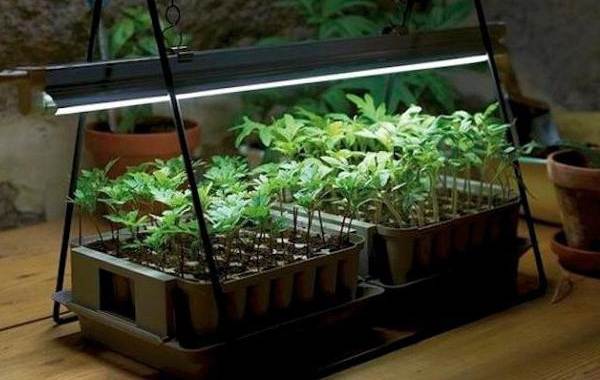

2. Induction. This subspecies of the lamps described above is more advanced. Indeed, in its composition there are no electrodes, which means that nothing will burn out over time.
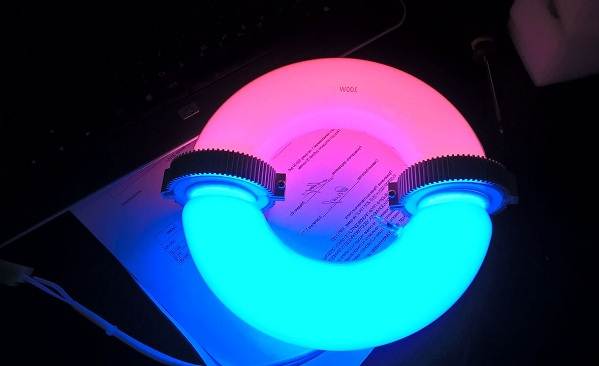

3. LED. They are by far the favorites among their competitors. These small pieces make it the perfect appliance. It will include both bluish and reddish light rays at once. Moreover, they will all be in the ideal spectrum. And this is 450 and 660 nanometers.
By the way, led phytolamp for plants suitable for absolutely all types of greenery. Another "For" this choice is the lack of heating. Here you can get the maximum heating up to sixty degrees. While other varieties are heated to temperatures seven times higher.
Not only will this protect the plants from overheating, it will also prevent the soil from drying out too quickly, which means that the number of waterings will decrease. The cost of such an acquisition, of course, will not please you.
But on the other hand, it is durable - the service life can be extended by as much as one hundred thousand hours. Moreover, LED phytolamp for plants will save the budget, because it shines clearly on the target, without wasting energy in vain.
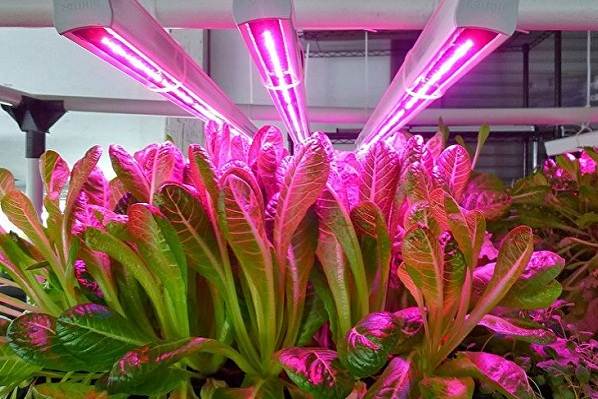

4. Energy saving. Here you will not be able to do with one-time expenses. Over time, a spectrum change will be required. Often they are scolded for lack of power. But you don't need to buy a special frame for such a light bulb, you can find an old lamp at home and insert it there. Such a neighborhood does not threaten plants with burns.
5. Sodium. Very bright. This is both bad and good at the same time.The good thing is that there will definitely be enough light for the plants, but the bad thing is that for people it is too strong an intensity, and without eye strain, a person cannot be in a room with such light.
This device will not heat the air, but it will heat up itself, moreover, to such an extent that the smallest drop of water on its surface can lead to a mini-explosion. This means that we should not touch it during work. For the product to work at full capacity, you need to wait about ten minutes after connecting it to the network.
Its luminous flux will not hit the target exactly. It will be distributed throughout the district. In the pros, you can add the fact that they are "not gluttonous" and durable. Mirrors are built into these devices so that the light goes where it is needed.
These can be plates based on aluminum, or with the use of silver alloys. Mercury is also among the components of the "luminary", so it will not work just to throw it into the trash bin after use.
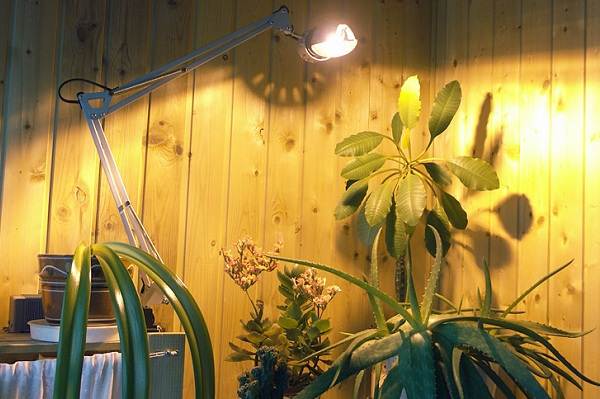

6. Metal halogen. They do not have a biting price, but problems may arise with the intensity of light over time, because the device loses it. Although initially it can give very good performance.
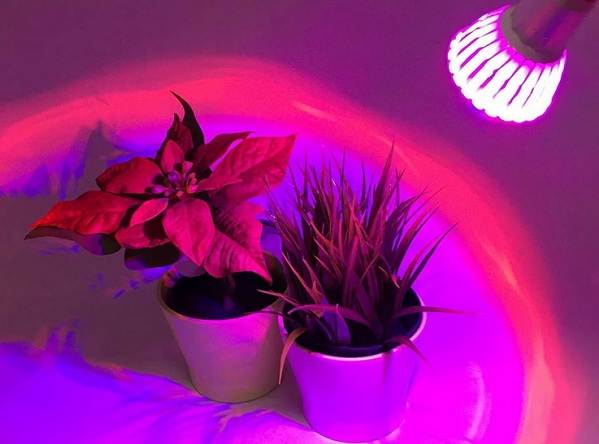

Which light is best for growth?
Solar energy is certainly the ideal light source. In apartments with windows to the southeast and southwest, you can grow any flowers by placing them at different points in the room. But do not be upset for those who have a view from the window only to the north side. Fluorescent and LED plant lamps compensate for the lack of sun rays.
Daylight plant lamps are a time-tested budget option. They are suitable for those who are trying to create normal conditions for a flower with a small investment. LED phytolamps for those who seek to force events and achieve the best results in a short time, despite the price of several thousand rubles.
Price
You can buy such a product at completely different prices. After all phytolamp price for plants fluctuates significantly. There are offers for a couple of hundred, and there are also for a couple of thousand rubles. Let's start with the least expensive shopping. Among them are fluorescent lamps. A 20-watt device will cost only about 300 rubles.
Then there are halogen installations with a price tag of one thousand. LEDs can be attributed to both the largest spending and the most modest. After all, the price for a budget option starts from one and a half thousand, but a better one is already about ten thousand.
Sodium is one of those that can be called "average" in terms of price. You can buy them for a couple of thousand. But the energy-saving ones will already empty the wallet by at least as much as five thousand.
Summing up
We hope that the material read has helped the reader to master the basic knowledge of organizing lighting for flowers in the house and on the balcony. Once again, I would like to emphasize the economy and high efficiency of LED lamps for growing plants, a massive transition to which is just around the corner. Let every florist who has the opportunity to purchase a phyto-lamp with LEDs today evaluate its power and leave a review for other readers in the comments below.
Flowers, which need certain conditions for successful growth, will help to decorate your home and make it more comfortable. Artificial lighting of indoor plants is especially important in winter, when daylight hours are reduced and flowers do not receive enough light for normal growth and development.
In this article, you will learn how to properly make artificial lighting for indoor plants and what requirements light sources must meet.
Check the spectrum of diodes in the phytolamp
It is generally known that plants need sunlight, which consists of different wavelengths and colors, for growth and development. In the spring, during the period of growing seedlings, when there is not enough sunlight, artificial lighting lamps are usually used to supplement the illumination of plants.However, their emission spectrum is limited and occurs mainly in the yellow and green color sectors. In addition, incandescent lamps consume a lot of electricity. Fluorescent and modern energy-saving lamps are more economical, but they emit little light in the red and orange spectral regions. And plants respond well by growing in response to blue and red colors.
Such an optimal combination of colors was achieved when using LEDs in phytolamps. Therefore, these light sources are called bicolor. To choose the right lamp, you need to look at the so-called spectrogram (see Figure 1). It is also on the packaging of the lamp itself. The spectrogram should have peaks in the blue and red sectors of the spectrum. In the blue sector, the optimal wavelength for seedlings is 440-450 nm, and in the red sector - 650-660 nm. If the spectral indicators deviate greatly in both directions, such a lamp is not worth buying, since waves of a different length are ineffective for seedlings.
How to make artificial lighting for indoor plants
It is well known that the level of illumination plays perhaps the most important role in growing flowers. After all, the processes of photosynthesis, which provide them with energy, occur exclusively in the light. At the same time, some species need bright light, others feel good in partial shade, and some generally prefer to stay in the shade.
Note: If all these varieties are grown in the same room, then it becomes clear that it is quite difficult to ensure the proper level of illumination for each of them.
Here artificial lighting comes to the rescue of a lover of home flowers, which is the easiest and most affordable way to provide the required amount of light if it does not come from a natural source (Figure 1). Proper placement of artificial light sources allows you to grow fresh flowers in almost every corner of your home.
Why do you need to illuminate plants
To understand the need for artificial lighting, you need to know that under the influence of sunlight in the green parts of crops (leaves, stems), photosynthesis processes take place, as a result of which the energy necessary for the growth and development of living organisms is released (Figure 2).
Note: Vases that receive insufficient light begin to wither, their growth slows down, and the leaves lose their color intensity. Therefore, if you pay enough attention to watering and feeding, and your green pets look depressed, pay attention to the light mode.
In addition, it would be nice to know in what conditions this species grows in nature. For example, representatives of the tropics and subtropics are accustomed to short daylight hours, while those from the temperate zone are accustomed to long days. For this reason, the former must be shaded in the summer and highlighted in the winter.
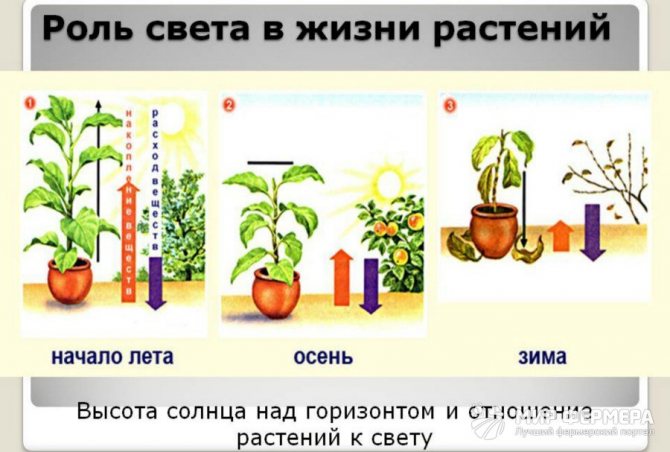

Figure 2. Influence of light on indoor flowers at different times of the year
The highlighting procedure can be carried out both in the morning and in the evening. At the same time, it is desirable that the dawn and dusk of home flowers are experienced in natural light. The total duration of artificial lighting should be within 12-14 hours a day, since green crops also need rest.
How much light do indoor plants need
Very often, when organizing artificial lighting, the question arises about the amount of additional light. A special device - a luxmeter, which measures the illumination level, will help to answer this question. So, for shade-loving varieties (poinsettia, begonia, ivy, calathea, arrowroot), illumination at a level of 700 - 1000 lux will be sufficient. At the same time, the lower limit of this indicator guarantees only the maintenance of the vital activity of the flower, therefore, to obtain flowering, the values must increase.
Shade-tolerant species, such as dieffenbachia, monstera, dracaena, ficus, fuchsia, prefer bright diffused light, but they can feel quite comfortable in the shade. Therefore, the additional illumination level for them is from 1000 to 2000 lux. But to ensure the normal functioning of light-loving varieties (pelargonium, roses, cacti, hibiscus), an illumination of 2.5 thousand lux will be needed, which must be increased to start budding and subsequent flowering up to 5000 lux. Indoor citrus fruits require a high level of illumination, which can form ovaries only at 8-9 thousand lux.
Why seedlings need lighting
Most gardeners begin planting seeds for seedlings in February or March. Light days at this time of the year are short, and seedlings of different cultures need 10-16 hours of light per day for harmonious development. With its deficiency, the seedlings stretch out strongly, the leaves turn pale and wither, after planting in the ground, the plants either do not take root at all, or they adapt to the new habitat for a long time. And on the contrary, those specimens that had enough light turn out to be powerful, hardy to the vagaries of the weather, they are characterized by a more developed root system, better resistance to diseases and pest attacks and, as a consequence of all this, increased productivity.
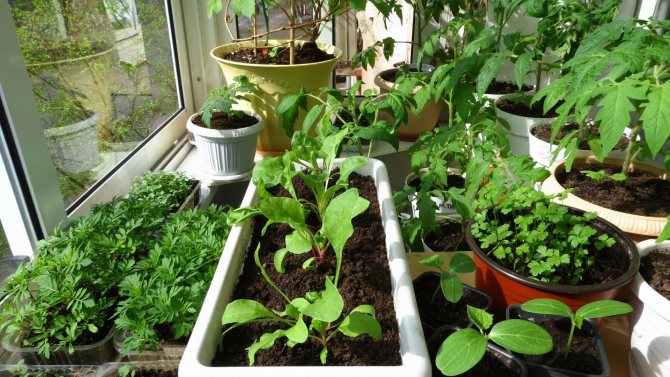

It is impossible to grow high-quality seedlings without good lighting, there is not enough sunlight at the end of winter and at the beginning of spring
Additional lighting for indoor plants
Various lamps (incandescent, fluorescent, gas-discharge) and LEDs are used as additional artificial light sources. Most often, gas-discharge and fluorescent lamps are used.
Be aware that ordinary household tungsten filament bulbs cannot be used to illuminate household colors for several reasons. First, they give low light intensity. Secondly, an excessive amount of red, orange and infrared rays is revealed in their spectrum, which stimulate the rapid growth of the culture, as a result of which the stem is too elongated.
How long should the plants shine?
Remember not to use bulbs all the time. Those. a break in their work is imperative. The total number of hours of supplementary lighting cannot exceed 14 in one day. Ideally, if during the day there is natural light, and about four to five hours will be spent on artificial. If you have just planted the seeds, and they have begun to germinate, then in the next four days it is worth providing them with a constant stream of light.
You should not try to give the plant the maximum dose of light in just a couple of hours, giving it the most powerful stream. Better let the rays of not such a strong force accompany the greens for a slightly longer time. If you do not want to track the time of switching on the devices yourself, you can set timers on them.
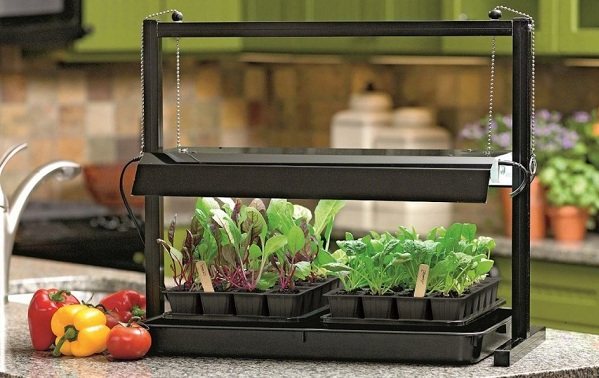

Lamps for lighting indoor flowers
Let's get acquainted with the main characteristics of lamps that are used for artificial lighting of indoor plants.
The most popular sources of additional lighting for indoor plants are (picture 3):
- Incandescent lamps they get very hot, but their light output is low, and the spectrum lacks blue waves, which are so necessary for the development of the body. Therefore, it is recommended to use such lamps in combination with fluorescent lamps or with sufficient natural light.
- Fluorescent lamps also called fluorescent lamps, although their spectrum is not absolutely ideal. These lamps heat up slightly with high heat transfer and are in operation for a long time.
- Phytolamps are considered more effective. Their luminous flux carries waves of blue and red spectra, which, when mixed, give a pink tint. Such lighting activates the processes of photosynthesis and, accordingly, affects the growth rate of flowers. However, such light is often unpleasant for humans.
- Discharge lamps allow you to illuminate large areas, for example, greenhouses, winter gardens, greenhouses. They are not suitable for home use, as they have a very strong light output.


Figure 3. Types of lamps for artificial lighting of flowers: 1 - incandescent, 2 - luminescent, 3 - phytolamps, 4 - gas-discharge
LED lamps have proven themselves quite well at home, in which you can combine the desired colors of the spectrum (for example, red and blue) to achieve the desired result. Such lamps do not heat up, they are economical and durable.
Features of using various lamps to illuminate colors are shown in the video.
How to choose a lamp
Having familiarized yourself with the technical characteristics of lighting devices, it is also necessary to know well what requirements for the intensity of illumination and its spectrum are imposed by the plant itself. Armed with the necessary baggage of knowledge, proceed to the selection of lamps.
Features of the
Immediately discard the idea of purchasing incandescent lamps, since they are absolutely not suitable for organizing artificial lighting of flowers. Stop your attention on more modern, and therefore more efficient and economical types. For example, fluorescent lamps are versatile. They can be used both at home and in a greenhouse, as well as in an aquarium. But special phytolamps are suitable only for seedlings and flowers.
Among the great variety of gas discharge lamps, the most advanced are metal halide lamps. They have high power, optimal radiation spectrum and long service life. The most effective, in terms of light output, are called high-pressure sodium lamps. A ceiling lamp made from such lamps can be used to illuminate a large collection of home flowers or a winter garden. However, they can only be used in non-residential premises. It is also recommended to combine the action of sodium lamps with the action of mercury or metal halide. An alternative can be modern LED lamps, the cost of which is quite high, however, it is justified by low consumption and a large resource.
The use of lamps for flowers
The role of a lamp for illuminating plants at home can hardly be overestimated: thanks to an additional light source, the process of photosynthesis, which is necessary for the life of green spaces, takes place. With a lack of lighting, the plants stretch out, the leaves become pale, the variegated color disappears, new leaves grow smaller.
Flowering plants shed their buds, and over time, leaves may fall off.
Replacing sunlight is not easy: artificial lighting must have a certain radiation spectrum and wavelength for the flower to adequately perceive the backlight.
A flower lamp will bring maximum benefit if the following waves enter the spectrum of its radiation:
- Red and orange - these waves are in the first place for the benefits of greenery. Photosynthesis cannot take place without them; they have a direct effect on the growth rate of flowers and the degree of their development.
- Blue and purple - not only participate in photosynthesis, but also stimulate the formation of protein substances in the leaves, accelerate the growth of shoots. Under the influence of the violet and blue spectrum, buds form and bloom much faster.
- Ultraviolet radiation - UV radiation with a wavelength of 315-380 nm and 280-315 nm is used for growing plants. The first type of waves does not allow plants to stretch, the second one increases their endurance and cold resistance.
Before buying a lamp, it is best to consult with experts or read the literature to clarify what type of lighting is needed for a particular plant variety. Each flower needs an individual illumination mode and if you take into account its needs, it will delight its owner with gorgeous leaves and exuberant flowering.
DIY lighting for indoor plants
Making lighting for indoor plants with your own hands is not so difficult. You will need:
- Prepare a place for placing the flowers and lighting themselves;
- Install fasteners for lighting fixtures;
- Conduct the wiring to the fixtures.
Recently, LED elements have become increasingly popular for organizing additional lighting. These lamps combine two very important spectra - red and blue. In addition, LED lamps consume a small amount of electricity, and their cost pays off in a short time, they are easy to install and simple to operate (Figure 4). The LED strip is attached to any furniture or wall with an adhesive backing.
To make an LED-based lighting fixture you will need:
- LED elements of red and blue spectra;
- Hot melt glue (thermal paste);
- Handy material for the base of the product;
- Power Supply;
- Cord, plug, switch.
When forming the LED strip, you should place its elements in the following sequence: 2 red, 1 blue element, etc., fixing them on the selected base with hot melt glue or bolts. The finished summer connects with the power supply, cord, switch and plug.


Figure 4. Options for homemade artificial lighting for indoor flowers
Also, take care of the rack, which will be convenient for placing indoor plants and lighting. As a material, use a metal corner or wooden beam, connecting the elements with bolts and screws. It is recommended to make no more than three shelves on one rack, each of which is illuminated by a separate device.
Consider the radiator area
The radiator is an aluminum body, which is located in a circle in the base lamps, or, if it is a linear lamp, the entire body is the radiator. In Figure 3 the radiator is indicated by arrows.
The radiator is designed to dissipate the heat generated by the diodes. Therefore, the volume of the radiator must be calculated for the number of diodes so that they do not overheat. The maximum temperature on the crystal of diodes should not exceed 70-75 ° C, otherwise they "degrade". That is, if there are many diodes in the lamp, and the radiator is small, such a lamp will quickly fail.
In order for the LED phytolamp to work properly, the ratio between the radiator area and the number of diodes must be well verified. The distance between the diodes is equally important, that is, if there is enough space between the diodes, the heat is distributed faster. An example of the correct "landing" of diodes on a radiator is shown in Figure 4.
You can find out detailed information about LED phytolamps from the following video:
Lighting for indoor plants in winter
In winter, almost all indoor plants lack natural lighting due to the short duration of daylight hours. Therefore, many species lose their decorative effect and stop growing.


Figure 5. Options for artificial lighting of indoor plants in winter
To preserve the attractive appearance of plants in winter, it is imperative to organize additional lighting (Figure 5). In this case, it is necessary to increase not only the intensity of illumination, but also the duration of daylight hours. Here are some useful tips on how to do this correctly and effectively.
Features of the
Conventional mirrors can help slightly increase the intensity of artificial light. To do this, they are installed on the side slopes of the windows, thus contributing to additional reflection of sunlight. Also, to increase the efficiency of additional lighting, reflectors are installed (foil, white glossy fabric, reflectors for lamps). At the same time, they are positioned so that they reflect light in the direction of indoor flowers.
Note: An interesting fact is that the curtains between the plants and the space of the room also help to reflect the stray light.On the other hand, hanging curtains between the window and the flowers can reduce the natural light intensity.
Do not forget to monitor the cleanliness of the window surface and reflective surfaces, regularly clean them from dust and dirt, because even the thinnest layer of dust significantly reduces the level of illumination. You should know that indoor plants, like all living organisms, have their own biorhythms, which are not recommended to be broken. Therefore, increasing the length of daylight hours, it is necessary to ensure that the additional illumination procedures are carried out regularly and at the same time.
Useful Tips
When choosing the type of artificial lighting, amateur flower growers are faced with many nuances, while it is not always possible to get answers to your questions. But there are a few rules or tips that you can use when arranging places where indoor green spaces will receive additional lighting:
- The luminaire is installed so that the light falls on the plant from above, as in natural sunlight.
- Distance from lamp to leaves should be from 25 to 40 cm.
- A 70 W lamp is installed per square meter.
- Artificial lighting is turned on in the morning at 7-8 o'clock, and turned off in the evening at 20-22 o'clock. This is how the biological rhythm of plants is observed, which is close to natural in the summer season.
- When growing seedlings lighting should be around the clock for the first few days after seed germination.
- It is convenient to place small plants on shelves, the optimal number of shelves is no more than three.
- To increase the efficiency of artificial lighting, reflectors are used, which can be made independently from white paper or foil.
- In winter, it is recommended to wipe the windows more often, since much more sunlight passes through the clean glass, which is also necessary for the plants.
- The backlight must be turned on and off at the same timeso that the plant does not experience changes in its life rhythm.
- It is not recommended to install a source of artificial lighting in the working or study area of the room, since prolonged exposure to light from a phytolamp can negatively affect vision, especially if there are children in the house.
Indoor plants gratefully respond to the additional lighting that they really need in the winter; owners immediately notice the improvement in the appearance of their pets after installing the flower lamp.
How to determine if a plant is low on light
For shade-tolerant plants, illumination levels from 1000 to 5000 lux are required, for light-loving plants - from 10,000 lux. You can measure the level with a special device. But if he is not, and usually it happens, then the plants will tell him when he has little light.
Insufficient lighting affects the appearance of any plant. First, the natural color of the leaves changes: young leaves grow pale and small, leaves with a variegated color (scindapsus, variegated ficuses and ivy) lose the brightness of the pattern, sometimes they just turn green. In many species, the lower leaves turn yellow, sometimes falling off.
In almost all species, the elongation of the shoots is noticeable, their curvature towards the light. If we compare the distance between the nodes of leaves that grew in summer and those that appeared in autumn or winter, the difference is very noticeable. For example, in Pelargonium, internodes are 2-3 times elongated.
An experienced grower will never wait for his plants to grow and begin to lose leaves. First of all, you need to know for sure whether a particular species is shade-loving or if it needs bright light, which can be found in the encyclopedia of indoor plants. And if there is a suspicion that the home flower is dark, then you should definitely install backlight lamps.
Many novice flower lovers, having learned about the possibility of using artificial lighting, begin to illuminate plants around the clock. But, contrary to expectations, they wither away. Plants also undergo the processes necessary for life in the dark.Regular alternation of day and night is essential. The flowering of many species depends on the change in these periods.
Consider the distance from the lamp to the light area
At what distance from plants should phytolamps be placed? The answer to this question will depend on which room and how many plants you plan to grow, as well as the length of daylight hours.
In order for the lamp to retain its functions, and the effect of such illumination does not diminish, it can be equipped with additional lenses in order to narrow the beam of light. The illuminated area will depend on the lenses selected. In order not to overpay for extra lamps and unnecessary power, it is better to pick them up with the help of professionals.
What lamps to choose for plant lighting
When choosing lamps for plants, it is important to know that not only the intensity, but also the spectrum of light radiation is essential. Optimal for all plants is the spectrum of daylight, which ranges from ultraviolet rays, through the visible, to infrared.
Artificial light sources give light to one degree or another similar to daylight, but not in the entire spectrum. It is known that chlorophyll, which directly converts light energy into organic energy, absorbs light best in the red and blue parts of the spectrum. Blue-violet light promotes the growth of green mass in the early stages of plant development, red light accelerates seed germination and shoot growth.
Various types of lamps can be used as light sources, such as: incandescent lamps, fluorescent lamps (LL), gas-discharge lamps (HR) and LEDs. Currently, professionals mainly use gas-discharge and fluorescent lamps to illuminate plants.
Ordinary incandescent lamps with a tungsten filament are poorly suited for these purposes - their light intensity is low, they heat up very much, there are too many red, orange and infrared rays in their spectrum, which accelerate vertical growth, therefore, under incandescent lamps, plants stretch out.
The closest to the daylight spectrum are fluorescent lamps, they are also much more economical than incandescent lamps. Many plants thrive best under these lights. Saintpaulias, balsams illuminated by fluorescent lamps bloom all winter without ceasing.
Recently, quite efficient and economical lamps based on LEDs have appeared on the market. By combining LEDs of different colors, lamps are obtained that emit in the desired regions of the spectrum and are useful at different stages of the growing season.
Special phytolamps are also sold. At first glance, they do not differ from ordinary lamps, but they form a luminous flux in the blue and red spectrum, designed to activate photochemical processes and have a beneficial effect on the rate of development. Mixing red and blue light produces magenta (pink) light. But such light is often unpleasant for humans.
Types of artificial lighting
The modern market is replete with a variety of indoor flower lamps, but not all of them can be effective and beneficial for green pets. It is important to remember the rule: you can not choose ordinary incandescent lamps as additional lighting.... This is due to three reasons:
- Absence in the emitted spectrum of waves that stimulate photosynthesis.
- Strong heating of lamps, risk of heat burns for flowers.
- High power consumption.
Therefore, as a lamp for indoor plants they use:
- Fluorescent lamps - can emit warm and cold light. These are economical lamps that give off light well, but their spectrum is not ideal for plant health. Despite this, fluorescent lighting is the most common among florists, thanks to which green spaces grow well even in very short daylight hours. If the characteristics of the luminaire indicate that it is a daylight plant lamp, it is a fluorescent lamp, since it is called daylight in everyday life.
- Phytolamps are considered the most useful for home flowers, as they emit waves of the blue and red spectrum. But such light can create discomfort for the human eye, therefore, such lighting is used more often for professional growing of flowers, in small greenhouses when germinating seedlings.
- Discharge lamps - used to illuminate large areas (greenhouses, greenhouses). At home, this type of lighting is not used due to its strong brightness.
- LED lamps are economical and durable luminaires in which the blue and red spectrum of radiation can be combined.
Little tricks of plant lighting
Ordinary mirrors will help to slightly increase the intensity of the most useful natural light. They are installed on the side slopes of window openings. As a result, the light is reflected in the side mirrors and the plants are much lighter. When only oblique rays of the sun enter the window for a short time, then such a little trick helps to extend the daylight hours. And, besides, a little sun in the room in winter will not be superfluous. Yes, and such a window looks quite beautiful, and the flowers are reflected in the mirrors and there are more of them.
To make the illumination of potted plants more effective, reflectors and reflective surfaces are used. They are positioned so that they reflect artificial light towards the plants. As a reflector, you can use foil, white glossy cloth or special reflectors for lamps. Traditional tulle curtains on the windows also partially reflect light, including daylight. If they separate the plants on the windowsill from the room, then the reflected and diffused light from the curtain hits the plants. If the tulle is located in the path of the sun's rays to the plant, then the light intensity decreases.
The length of the daylight and the correct alternation of day and night are extremely important for all plant species. It is not at all useful to shine irregularly, from time to time, knocking down the biorhythms that all living things obey. To maintain the optimal regime, the timer is indispensable! The presence of a timer is also important in order to safely leave powerful lamps turned on at home, leaving early in the morning for work. They will turn off after half an hour, even if you forget to do this before leaving.
It is useful to regularly monitor the condition of the window and reflective surfaces, to clean them of dust and dirt. The window appears clean and transparent, but a thin layer of dust greatly reduces the intensity of daylight.
How to enhance natural light
The most economical way to improve seedling lighting. The surface of the window sill is lined with foil, behind the containers with seedlings, a “screen” made of cardboard 15–20 cm high, pasted over with it, is installed. Or pots, containers are placed in a foil-pasted box with a cut-out wall facing the window.
The sun's rays, passing through the glass, are reflected from the foil onto the plants, the illumination is improved by 20-30%. Moreover, the light comes evenly from all sides, the problem of stretching the stems towards the window and the need to regularly turn the containers disappears.
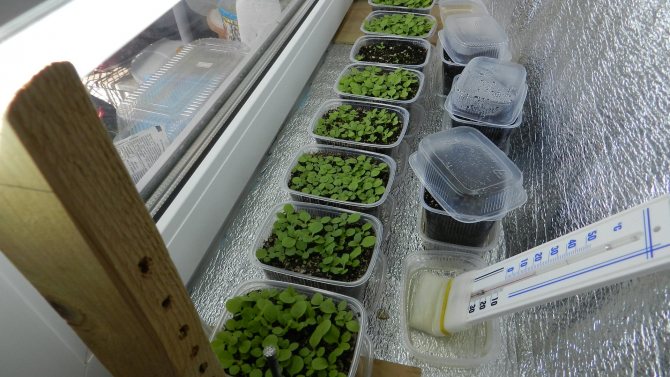

The foil screen can be replaced with a thin white fabric, for example, coarse calico - in this case the light will be softer, more diffused
But this technique does not solve the problem of cloudy days and north-facing windows. It is also ineffective in the presence of a large number of seedlings, when the containers are on the windowsill in several rows or on racks with shelves at different heights.
Video: foil screen to enhance natural light
What the three Fs say
When creating artificial illumination of indoor flowers with your own hands, you need to remember the rules of three "F", which reflect the main processes in which light plays a leading role. The rules of three "F" include the following concepts:
- photosynthesis. It requires a red spectrum of light. Thanks to it, plants receive energy and release oxygen as a by-product of metabolism;
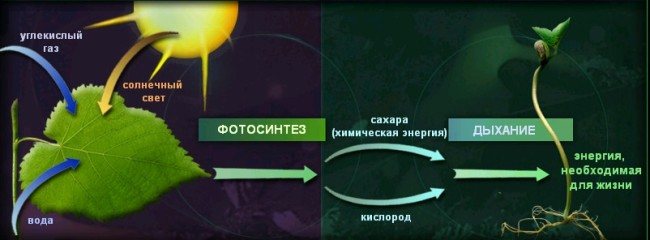

Photosynthesis
- photomorphogenesis. This process determines the growth and development of indoor flowers. It depends on the wavelength.If it picks up waves of blue, then the leaves and stems will stretch;
Note! For optimal growth and development of a home garden, you need to use a mixture of red and blue spectra.
- photoperiodism (movement to light). Reflects the plant's reaction to light and dark periods of the day. For example, the movement of flowers is observed in the light, but at night they are closed.
Without considering these three "F" s, you will not be able to create optimal growing conditions for indoor plants. In addition, it must be remembered that half of the success of organizing artificial lighting with your own hands is the correct selection of lamps.
Plant groups according to light needs
By the amount of light required, indoor plants can be conditionally divided into 2 main groups: light-loving and shade-tolerant, content with moderate lighting.
There is also an intermediate group - plants that prefer partial shade. This group includes only some types of light-loving or shade-tolerant genera. A striking example is Aglaonema, whose natural species grow in forests, and therefore are shade-tolerant. However, variegated ("variegated") varieties prefer diffused light, without which they can lose their original color.
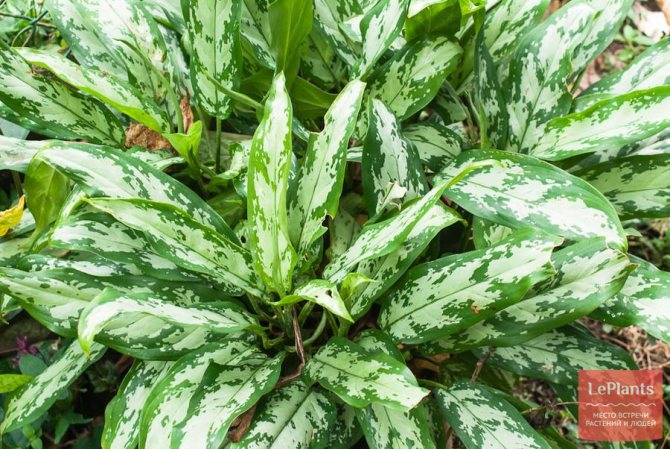

ON THE PICTURE: Aglaonema variegated does not tolerate a lack of light as easily as species with monochromatic leaves
The first group includes desert plants - Sedum, cacti, Hawortia, Hoya, Gasteria, Coleus, Croton, Eucalyptus. The second group includes Ivy, Fragrant Dracaena, Saxifrage, Monstera, Aspidistra, Begonia.
You can even visually determine which group a particular plant belongs to. It is enough to take a closer look at it. So, shade-tolerant species have a dark green color, their leaves are wide, dull, sometimes quite dense. The shoots of such plants are long, most often thickened. Light-loving species, on the contrary, have light green, equilateral, narrow and shiny leaves, often hard and thin. Shoots are short, hairy.
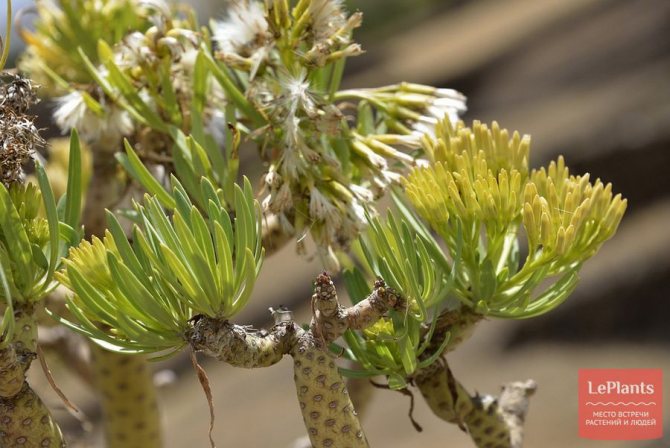

ON THE PICTURE: Kleinia loves to swim in the sun
As for the so-called "Shade-loving" species, then not a single flowering plant likes a shadow. But their "younger" brothers (although evolutionarily they are more likely "grandparents") - mosses, lichens and ferns prefer the shade, because can get burned in the light. Therefore, shade-loving plants are isolated into a separate, uncommon group with their own specific conditions of detention.
You can determine which group of plants your flower belongs to by visiting our "Encyclopedia". The "Illumination" characteristic is indicated by the "sun" icon. Hover over it and you will find out how much light your plant needs.
Table: description of characteristics
Read also: Peat tablets: how to use it correctly, the device of a mini-greenhouse for seedlings (20 Photos & Videos) + Reviews
| Model name | Power, W | Number of LEDs, pcs. | Price, rub |
| JazzWay PPG A60 AGRO 9W Е27 Frost 5002395 | 9 | — | 253 |
| NAVIGATOR 61 202 NLL-FITO-A60-10-230-E27 | 10 | — | 267 |
Kreonix T8 | 15 | 5 | 313 |
| Camelion Phyto LED15-PL / BIO 15 W E27 | 15 | 5 | 519 |
| Lira "NPO FITOVATT" | 24 | — | 1100 |
GR14 655mm | 25 | 420 | 1378 |
Health Treasure Growing 16 W | 16 | 48 | 1499 |
| Perseus "NPO FITOVATT" | 24 | 8 | 1600 |
Flora Lamps Е27 120w | 30 | 36 | 3500 |
Garden Show Optimum | 14 | 225 | 4090 |
back to menu ↑
See also: Home flower hippeastrum - a multifaceted hybrid: description, types, care, cultivation, reproduction and other useful information (160 Photos) + Reviews
JazzWay PPG A60 AGRO 9W Е27 Frost 5002395
Read also: Lunar calendar of the gardener and gardener for 2019


JazzWay PPG A60
JazzWay PPG A60 AGRO 9W Е27 Frost 5002395 Pear-shaped model for e27 base, made of frosted glass. The work gives the ratio of the spectrum of red and blue colors as 5 to 1 (650 and 450 nm, respectively)... The area of illumination of the surface depends on the height of the lamp above the plants: from 84 to 230 cm.
Installed at a height of 20 to 50 cm above the top leaves of plants or seedlings. Within the limits of the operating temperature from -10 to +40 degrees, the lamp can last up to 20 thousand light hours. The radiation angle is 120 degrees, while the photosynthetic flow rate is 10 μmol / s.
PROS:
- inexpensive
- compact
- universal bicolor
MINUSES:
- low-powered
- polycarbonate body
- short service life
back to menu ↑
See also: Kalanchoe Flower (120+ Photos & Videos) - home care, transplant, reproduction, beneficial properties + Reviews
NAVIGATOR 61 202 NLL-FITO-A60-10-230-E27
Read also: We use manure as fertilizer: horse, rabbit, chicken, cow, pork, liquid and dry manure, as well as ready-made mixtures + Reviews
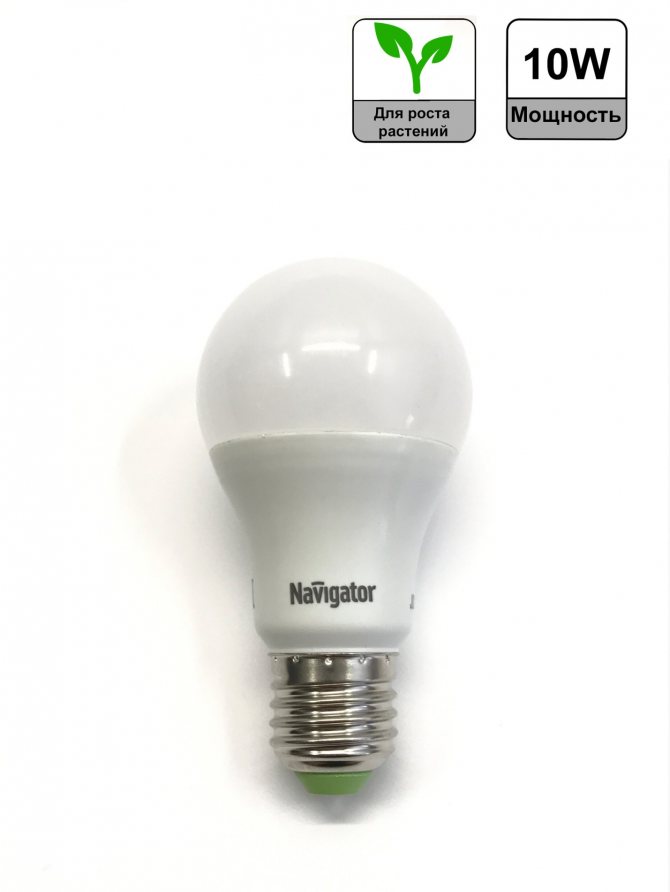

NAVIGATOR 61 202 NLL-FITO-A60-10-230-E27
NAVIGATOR 61 202 NLL-FITO-A60-10-230-E27 The basement low-power (10 W) model gives a photosynthetic flow of 19 μmol / with an angle of 270 degrees. A universal bicolor (red / blue) phytolamp will last 40 thousand light hours.
The glass flask is matte, the parameters of the pear-shaped apparatus are 11.2 cm by 6 cm, with a weight of only 120 g. The device works properly at air temperatures from -10 to +40 degrees.
PROS:
- energy saving model
- affordable price
- wide beam angle
MINUSES:
- low efficiency
- low degree of protection against dust and splash water (IP 20)
- only under the base
back to menu ↑
See also: Pansies: 10 species, a description of the process of growing from seeds in the open field and seedlings at home, the use of flowers (60+ Photos & Videos) + Reviews
Kreonix T8
Read also: The value of superphosphate as a mineral fertilizer in the care of tomatoes, potatoes, seedlings and other crops. Ways to use it in the garden + Reviews
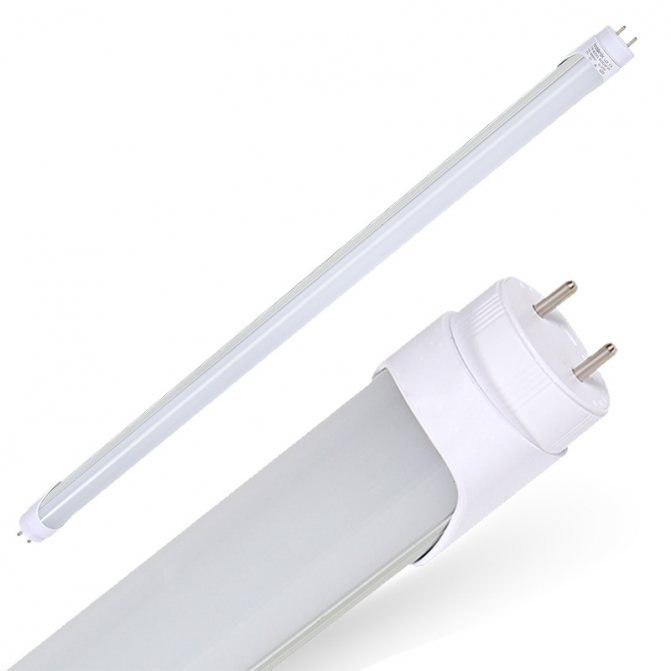

Linear lamp Kreonix T8
Kreonix T8 A linear phytolamp with a matte light bulb 90 cm long consumes 15 W, which corresponds to the power of 30 W of a luminescent analogue. The radiation angle in the Kreonix T8 model is 120 degrees, the service life is 50 thousand light hours.
The color spectrum is blue (wavelength 450 nm) and red (wavelength 660 nm), the shade of white is pink.
PROS:
- also suitable for lighting aquariums
- compact
MINUSES:
- exclusively for G13 (T8) base / plinth
- not protected from splashing water
back to menu ↑
Read also: TOP-15 Best tile adhesives: choosing the right product for the bathroom, underfloor heating, porcelain stoneware and outdoor work | + Rating
Camelion Phyto LED15-PL / BIO 15 W E27
Read also: Fertilizer for indoor flowers. Description of fertilizer types, recipes for home dressings + Reviews
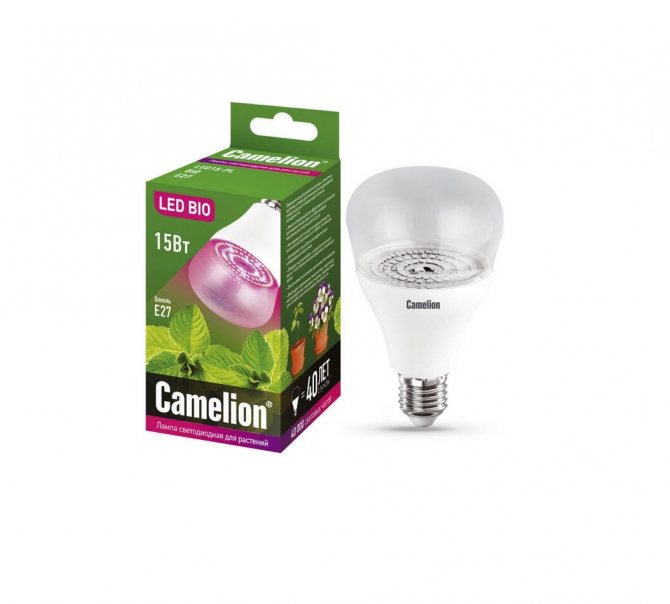

Camelion Fito 15 W
Camelion Phyto LED15-PL / BIO 15 W E27 Replenishing the lack of sunlight for indoor plants, the Camelion Fito lamp is also suitable for seedlings, creating optimal conditions for growth, ovary and fruiting. The lamp has a power consumption of 15 W, suitable only for the e27 base, with a bicolor emission spectrum: blue (23%) and red (77%).
The lamp is placed at a distance of 15 to 100 cm from the plants, forming a light beam angle of up to 120 degrees. It is allowed to use at temperatures from -30 to +40 degrees, while the service life is more than 30 thousand light hours.
The photosynthetic photon flux of the model is 25 μmol / s, the diameter of the illumination circle when suspended at a height of 50 cm is 174 cm.
PROS:
- universal, compact
- does not contain mercury
- low power consumption
- low ripple ratio (10%)
- compact (13.8x8 cm)
MINUSES:
- only suitable for base / plinth e27
back to menu ↑
See also: TOP-10 Best septic tanks for summer cottages: current rating of local treatment facilities, serviced and autonomous (without pumping) | 2019 + Reviews
Lira "NPO FITOVATT"
Read also: TOP-12 Best Knife Sharpeners: Rating of Quality Blade Sharpeners | 2019 + Reviews
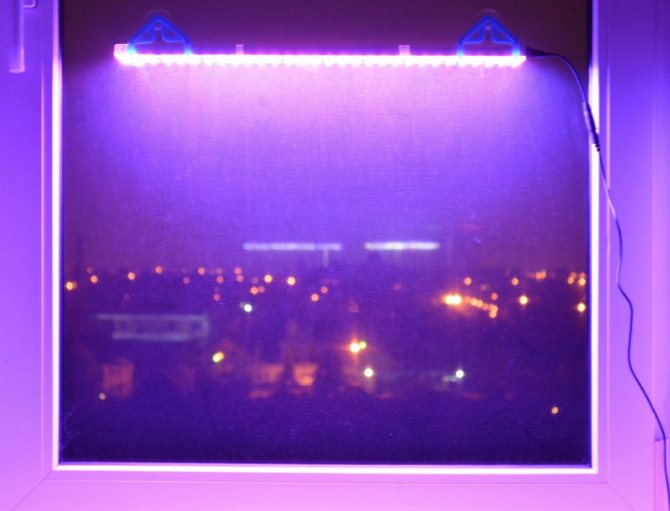

Option for fixing a lamp for plants "Lyra" above the windowsill
Lira "NPO FITOVATT" Phytolamp of Russian production, which differs from analogues by the original attachment on suction cups. It looks like an LED strip, gives an illumination of 2700 Lx. The length of the device varies from 20 cm (2.4 W) to 200 cm (24 W), the height and width - 1.2 cm each.
From individual lamp blocks, you can create clusters for lighting a greenhouse, winter garden, greenhouse. Bicolor LEDs - red and blue are optimal for enhancing the growth and development of plants and seedlings. The lamp gives a bright light, but does not burn the leaves.
PROS:
- power supply included
- easy to move
- mounts even on glass, horizontally and vertically
- can be combined with other phytolamps
MINUSES:
- very narrow - gives a small streak of light
- need mounting space, cannot be hung
back to menu ↑
See also: [Instruction] Soldering polypropylene pipes with your own hands: a description of the types of materials used, components and tools | Video
GR14 655mm
Read also: TOP-12 Best Electric Stoves with Oven for Your Favorite Kitchen | Overview of proven models
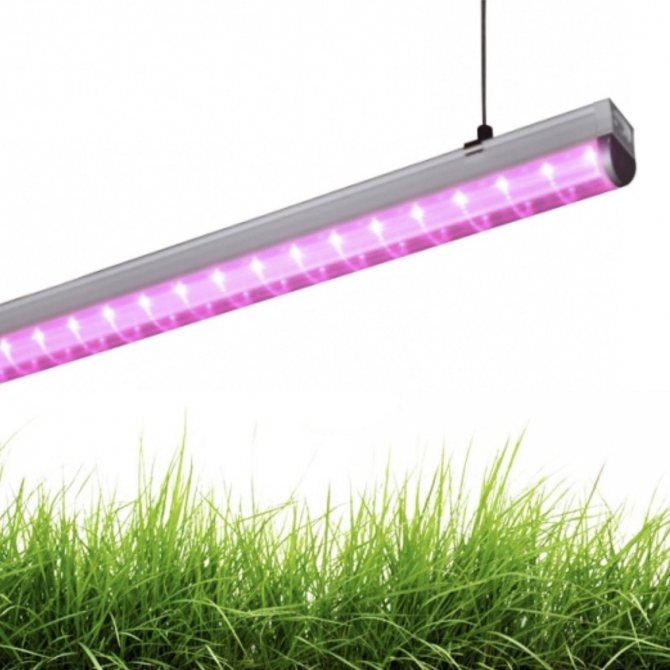

Schematic drawing of model GR14 655mm on aluminum hangers
GR14 655mm The device in an aluminum casing on a wire suspension combines 420 LEDs with red (210) and white (210) glow. The color pink is easily perceived by human eyes and has a beneficial effect on the development of plants. The illumination angle guaranteed by the device is 120 degrees.
Phytolamp power - 25 W. The length of the model is 65.5 cm with a width of 75 mm, the device weighs only 0.5 kg.
PROS:
- small, lightweight lamp
- reliable fastening system
- the case does not heat up
- no noise during operation
- it is possible to connect LEDs in a continuous circuit
MINUSES:
- low power of the device with a large number of LEDs
- cannot be placed on a windowsill, only suspended
- only used in dry rooms
back to menu ↑
Read also: TOP-10 Best voltage stabilizers 220V for a private house | Rating + Reviews
Health Treasure Growing 16 W
Read also: How to make a greenhouse with your own hands: for seedlings, cucumbers, tomatoes, peppers and other plants. Polycarbonate, window frames, plastic pipes (75 Photos & Videos) + Reviews
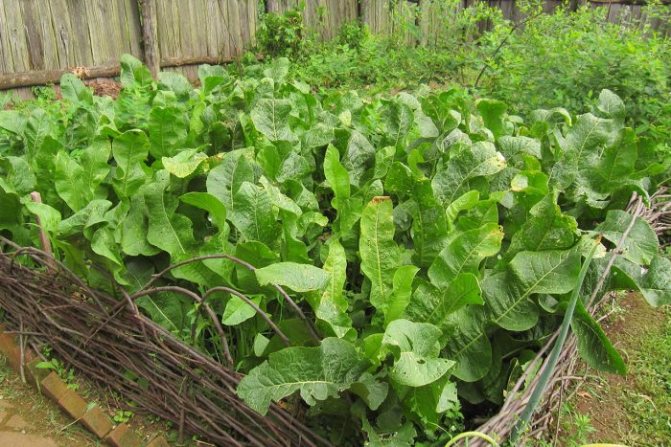

The principle of the "growing" luminaire
Health Treasure Growing 16 W A model that is used both as the main light source and for supplementary lighting of indoor plants. It is characterized by a low level of energy consumption (16 W) with a powerful photon flux of 24.5 μmol / s. The device at the expense of 48 diodes gives a full spectrum light with a creamy glow pleasant to the human eye.
It is positioned as a "growing" light for plants by adjusting the height of the device. The working part rotates along the axis, making it possible to illuminate the seedlings or plants at an angle. High efficiency is achieved with continuous operation for 8-14 hours.
In total darkness, it can illuminate up to 50 cm2 of surface area. It works optimally with an air humidity of 85%, temperatures from 0 to 45 degrees. The parameters of the model are 56x56x22 cm, the body is made of a combination of steel and plastic.
PROS:
- ease of assembly and use
- the switch is located on the body
- the set includes a support stand and a limiter
- each LED module works more than 30 thousand hours
- II class of protection against electric shock
MINUSES:
- no protection against splashing water
- the case heats up quickly
back to menu ↑
Read also: TOP-13 of the Best chain saws: for home or summer cottage | Rating 2019 + Reviews
Perseus "NPO FITOVATT"
Read also: TOP-50 Ornamental plants that purify the air in our house or apartment (50+ Photos & Videos) + Reviews
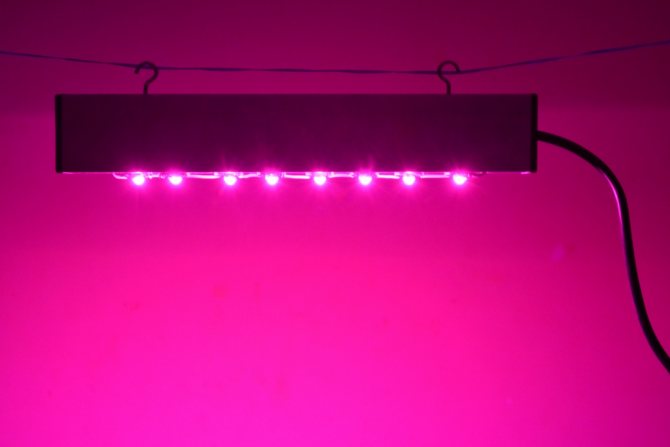

Linear configuration of the lamp for plants Perseus from "NPO FITOVATT"
Perseus "NPO FITOVATT" LED plant lamp, "Perseus" is used for supplementary lighting of indoor plants in conditions of lack of sunlight. When growing seedlings, it is optimal for cucumbers, vegetables, onions.
The device is placed on windowsills up to 1.4 m long using a fastening system. The lamp has a compact size of 3x3 cm, and the length is adjustable from 0.4 to 2 m... The body is made of aluminum, so it does not heat up during operation.
The total productivity of 8 LEDs of the "Perseus" phytolamp is 24 W (3 W for each). The options are full spectrum glow, as well as with the addition of bicolor and white light. Gives an illumination of 3500 Lx.
PROS:
- low power consumption
- promotes the acceleration of growth, vegetation, fruiting of seedlings
- does not make noise
MINUSES:
- unreliable fastening system
- for placement on windows only
back to menu ↑
Read also: TOP-10 Best coffee machines for the home for making an invigorating drink | Rating 2019
Flora Lamps Е27 120w
Read also: TOP-12 Best food processors: rating of proven models | 2019 + Reviews
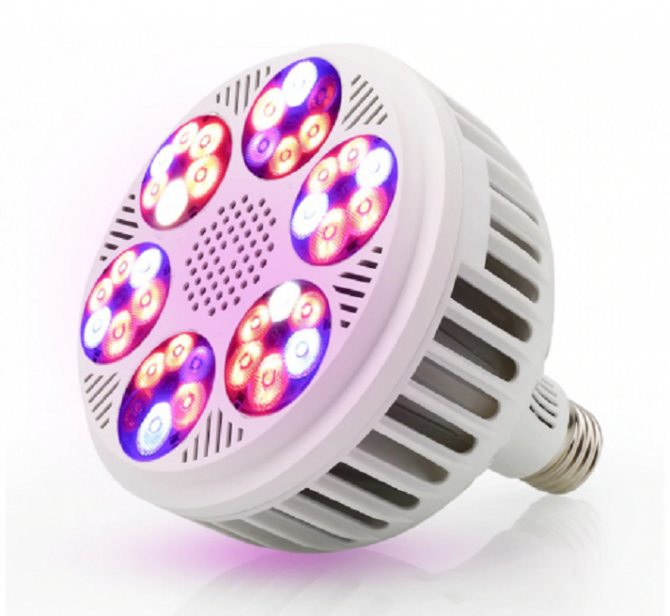

Plinth model Flora Lamps Е27 120w
Flora Lamps Е27 120w A full-spectrum device for supplementary illumination of indoor, flowering or fruiting plants, it is also used to increase productivity and accelerate the maturation of seedlings. It is made of plastic and weighs only 255 g, while it consists of 36 high-performance LEDs (22 red, 8 blue, 1 white, 2UV, 2IR, 1 warm).
The lamp provides full spectrum light at a 120 degree angle. Placed at a height of 100-120 cm above the top of the foliage. The device remains operational at temperatures from -20 to +40 degrees, while the case does not overheat.
The Flora Lamps E27 120w model has a ventilation system that extends the life of the LEDs while maintaining their high performance. The lamp power is 120 W, with a power consumption of only 30 W.
PROS:
- service life - more than 50 thousand hours
- compact size (14x12 cm)
- bright light
- high-quality assembly
- silent cooling
MINUSES:
- only suitable for base / plinth e27
- ineffective for plants on windowsill due to spot lighting
- high price
back to menu ↑
Read also: TOP-12 Best waffle iron: current rating of devices for making crispy baked goods | 2019 + Reviews
Garden Show Fitopanel Optimum 14 W
Read also: Popular plants for landscaping and decorating children's rooms and preschool premises. Recommended and Banned (25 Photos & Videos) + Reviews
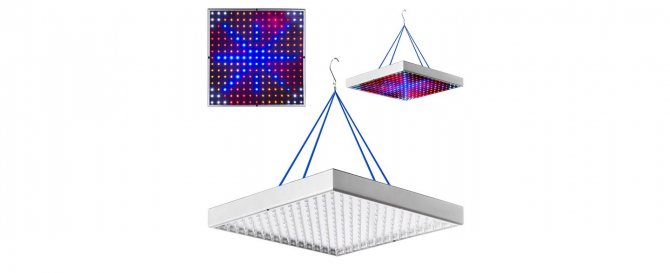

Wide dimensions of the Optimum phytopanel from Garden Show provide a large field of illumination
Garden Show Fitopanel Optimum 14 W Panel-shaped phytolamp with 225 bright red (84), orange (76), blue (41) and white (24) LEDs. The device is placed even at a minimum distance (200 mm) from indoor plants and seedlings, since the light does not cause burns on the leaves. Lighting promotes growth, strengthening, stimulation of flowering, seed germination and fruiting.
The dimensions of the device, made of plastic and metal, are 31x31x3.4 cm, weight - 1.4 kg. The set includes a hook for hanging the phytolamp over a horizontal surface. Does not produce side UV radiation, the housing does not heat up during operation.
PROS:
- economical and compact
- does not make noise
- can be moved
- many LEDs - large coverage area
- the spectrum of colors is close to the usual for human optical perception
- suitable for supplementary lighting of plants, and for growing seedlings
MINUSES:
- high price
- no stand
- cannot be combined with other types of supplementary lighting
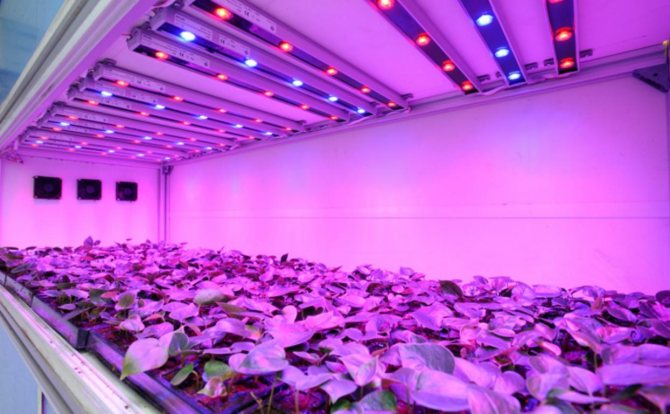

Lamps accelerate the processes of photosynthesis in plant leaves, promoting growth and development
When choosing a reliable high-quality phytolamp, one proceeds from the goals that need to be solved. For growing seedlings, a home greenhouse or a winter garden, powerful models with full or multispectrum LEDs, a wide beam angle and bright light are suitable.
For artificial supplementary lighting, the indicators of the photosynthetic flow and the level of illumination are important - the higher they are, the faster the growth and development of plants takes place due to the processes of photosynthesis.
For several pots with indoor plants, a low-power narrow-beam beam with a radiation spectrum is sufficient - a universal bicolor (red and blue). A weighted solution is an e27 LED light bulb, which is screwed into a stationary base from an ordinary table lamp.
See also: Growing herbs at home - all year round with vitamins: onions, parsley, basil, garlic, the subtleties of this process
Seedling illumination - LED phytolamps for plants. Overview. Which one to choose?
TOP-10 Best phytolamps for growing seedlings and indoor plants: choosing which one is better? | Rating + Reviews
back to menu ↑
See also: What should be the electrical wiring in a private house, do-it-yourself installation, instructions for beginners
Features of seedling lighting
When self-cultivating tomatoes, cucumbers, peppers, thin phyto-lamps with a set of clamps will be required. During germination, the seedlings are illuminated continuously for the first 4 days. Three days later, the duration of additional illumination is brought to 16 hours, after another 2-3 days to 14 hours.
The most light-loving are tomatoes, they are illuminated for 15-17 hours. Pepper and eggplant bushes are less whimsical, they have enough light for 11-13 hours.
To illuminate a window sill up to 1.5 m long, use:
- One lamp with a power of 80-100 watts.
- Two lamps of 40-65 W.
The illumination for seedlings is at the level of 6000 lux (slight deviations to the lower side are allowed when the containers are located on the southern windowsills, an increase when localized from the north). The need for the distribution of color spectra for seedlings:
| Culture | Red,% | Green,% | Blue,% |
| Tomatoes | 65 | 15 | 20 |
| Pumpkin (cucumbers, zucchini) | 40 | 40 | 20 |
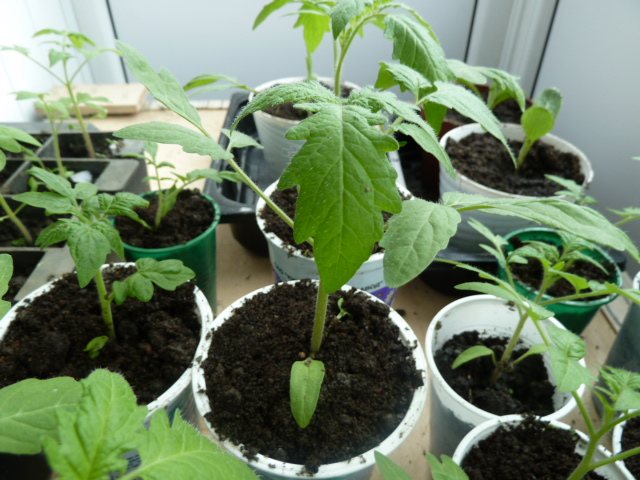

When placing containers with seedlings on the windows, suction cups, hooks, scotch tape are used for fastening. If large volumes of seedlings are placed on racks, cabinets will require a built-in system of several phytolamps, functional greenhouses with lighting.
The distance at which the light sources are located depends on the stage of development of the seedlings. When the first shoots appear, the lamp is placed close - within 12-15 cm. For bushes that are 2-3 weeks old, the lamps are raised to a height of 25-30 cm.
Conclusion
In apartments and houses for the full development of green assistants, natural light may not be enough in any of the seasons. Backlighting is an important condition for the effective cultivation of flower, ornamental, vegetable crops. Using artificial sources, you can emphasize the beauty of lines, decorate the interior, set a style and a special mood.
Now read:
- Planting to decorate the site with three types of conifers
- The main technologies for growing peas and caring for them
- Timely introduction of dolomite flour for the harvest
- Confidentiality
About
Agronomist of the state agricultural enterprise "Garovskoye" of the Khabarovsk region of the Khabarovsk region.
Phytolamps for highlighting seedlings and plants - reviews from the forums:
Elena, Moscow.
I have not used lamps before for additional lighting of plants, but this year I bought it - I can boast of my own harvest of onions, when I received almost 3 kg of greens from one container.


Igor, Tver.
I used phytolamps to illuminate greenery in the greenhouse - for the second year already, the harvest pleases with fragrant parsley and dill for the third year, both in summer and winter.
We design LED lighting ourselves
The convenience of LEDs is that they can be positioned as you wish. Better, of course, to do them in two lines - for the sake of uniformity of illumination of the entire area. Also remember that each LED has a light cone with an angle of 70-120 ° C, and therefore they need to be positioned so that the projections of the cones overlap each other.
LED lamps are already used by those who have understood well what plants really need and have tried all other types. This is a conscious choice in favor of low energy consumption and the ability to create your own personal spectrum. Even by combining a variety of spectra through LEDs, today unprecedented varieties are grown! And for good strong seedlings, it is also useful to combine different spectra at different times:
- Before the pick. Here it is better to use blue and red LEDs in a two to one ratio. Blue well stimulates root growth, but slightly slows down the development of the stem - so that it grows more not upward, but in breadth. The stem is thick, and there is a short distance between the leaves.
- After the pick. And here it is better to reduce the light intensity for a couple of days. Indeed, at this time the plants are under stress, and they need a period of rest for some time.Therefore, for about a month, supplement the sprouts with a 1: 1 ratio - blue and red.
So here's how you can make your own lighting. The first step is to purchase several LEDs in a specialized store:
- Red 3GR-R in the amount of 30 pieces, with a wavelength of 650-660Nm.
- White 3HP2С 3800-4300K in the amount of 10 pcs, and pure white 4800-5300K - also 10 pcs. The first ones correspond in their parameters to the midday sun, and the second ones correspond to the morning sun.
- Blue 3GR-B 445-452Nm in the amount of 20 pcs.
And the drivers for them: HG2217 and RLD10 PWM. All of this can also be purchased in online stores.
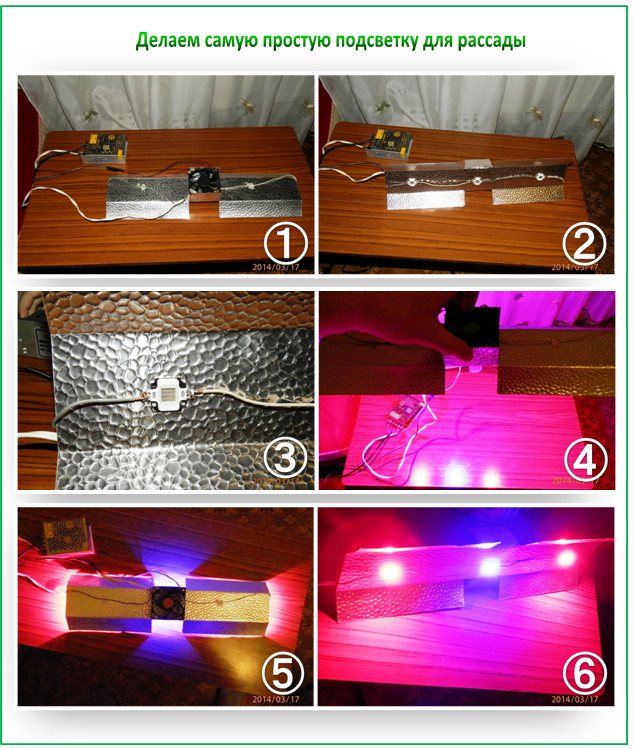

We implement the scheme in such a way that a wide variety of colors and their combinations can be included. For example, 20 blue and 20 white. The lamp housing should be a 2-lamp industrial luminaire. Just remove the inner filling from it.
We attach the LEDs with hot glue - directly to the aluminum plastic. By the way, it can be purchased at a regular hardware store. Then we fix the fans - even those that remain from old power supplies will do.
Here's how easy it is to build an LED seedling light. What you need for this:
- Power supply 24 V and 2 A DC.
- 12V power supply for the cooler.
- Computer cooler for cooling.
- Anodized aluminum strip - to conduct heat away from the diodes.
- Blue LED Matrix 10W Integrated High power LED.
- Two red LED arrays 10W Integrated High power LED.
- Wires, hot melt and epoxy glue.
Then follow these instructions:
- Step 1. Strip the ends of the wire sections and coat them with melted tinplate.
- Step 2. We solder the diode matrices to the ends so that "+" and "-" from adjacent diodes are connected.
- Step 3. We solder the wires to the extreme remaining ends, which we then attach to the output of the power supply. It is important that the number of diodes is selected so that their operating voltage is in total equal to the parameters of the unit - if it is 24V, then the same is needed.
- Step 4. Take a strip of aluminum and make two "ears" in it for attaching the cooler with hot melt glue.
- Step 5. Glue the diode chain to the aluminum with epoxy glue.
- Step 6. Bend the edges of the aluminum strip so that it becomes a reflector.
- Step 7. Plug in - everything works!
Believe me, you can do it!
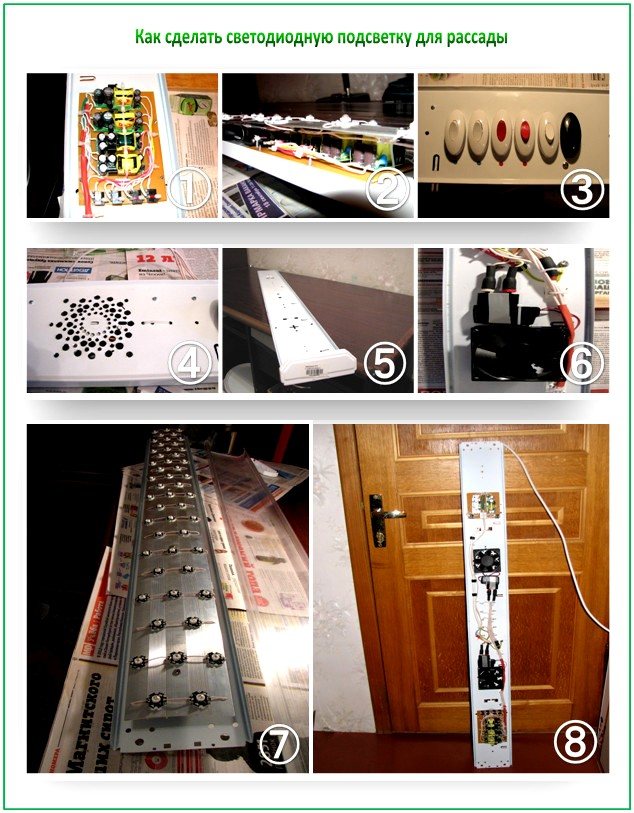

Content
- 1. Groups of plants according to needs in light
- 2. What plants require additional lighting in winter?
- 3. How to supplement the illumination of plants? Plant lamps
- 4. How to organize supplementary lighting of a plant?
- 5. How to understand that the plant lacks light?
- 6. A few tips in the end
The most unique and striking property of plants is the ability to create complex organic substances using sunlight. This property is not possessed by any other living creature on the planet! However, different plants have different requirements for light, and they depend, first of all, on the origin of a particular species. So, African Aloe, growing in the desert and accustomed to being under the scorching rays of the African sun, needs much more light than Aspidistre, an inhabitant of the gloomy tropical forests of Indochina.
Is daylight enough
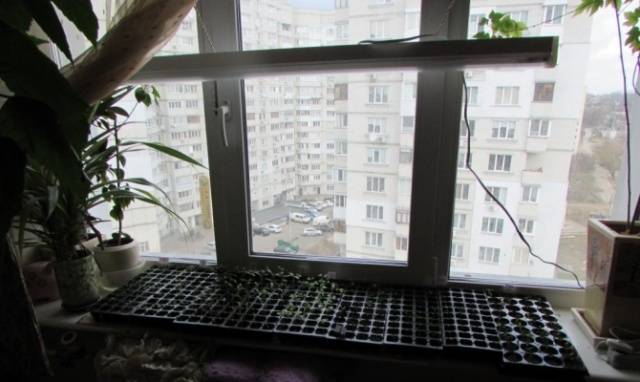

Lack of daylight due to short day lengths is one part of the problem. Seedlings stand on the windowsill behind each other. Plants closer to the window shade distant plantings. And if there is a rack on the windowsill, the light falling from the top from the window, close the shelves of the above tier. The second problem arises - the lack of lighting during the day.
The seedlings begin to reach for the cocoon glass. The stems become thin. The leaves are lethargic, underdeveloped. They try to solve the problem by turning the boxes. From careless movements, the sprouts break or fall to the ground.
Advice! To enhance the intensity of natural light, reflectors made of mirrors or foil, installed opposite the window glass on the other side of the drawers, help. However, in cloudy weather, the method is useless.
Self-made device
Do-it-yourself phytolamp for plants is a very real idea. If it is impossible to purchase a device in a store, there are simple and inexpensive ways to manufacture it that do not require a lot of time. They carry out the work in stages:
- First, you need to draw a diagram, taking into account all the technical parameters, so that each diode overlaps the neighboring one, and the entire area is illuminated evenly.
- Procurement of the required materials: body from an old lamp, 20 white, 30 red, 10 diodes that simulate midday lighting, and 20 blue diodes.
- The assembly of the device consists of attaching diodes with hot glue to the aluminum plate, installing a circuit breaker and connecting the device to the mains.
If you are not versed in electricity, you should not resort to self-manufacturing of the specified structure.
You can make a mistake, which in the future will lead to serious consequences, up to a short circuit of the electrical wiring.
Discharge lamps
An excellent solution for lighting greenhouses or greenhouses. High-pressure gas-discharge phytolamps are connected to the power grid through a special ballast. They are small in size, but they give a lot of illumination. There are three types:
- mercury;
- sodium;
- metal halide.
Mercury lamps are practically out of use among florists. Due to the special coating inside the bulb, they have an unpleasant blue glow and low light output.
A sodium lamp with a built-in reflector has the amazing ability to illuminate an entire greenhouse or conservatory. Light output is very high, and the duration of continuous operation is 12-20 thousand hours. The disadvantage is the predominance of red spectral colors, therefore, for full illumination, it is better to use another lamp that compensates for the lack of blue color.
The most optimal among gas-discharge lamps is metal halide. It has a spectrum suitable for colors, high luminous efficiency and high power. The only drawback is the high cost. In addition, a special cartridge is required for installation.
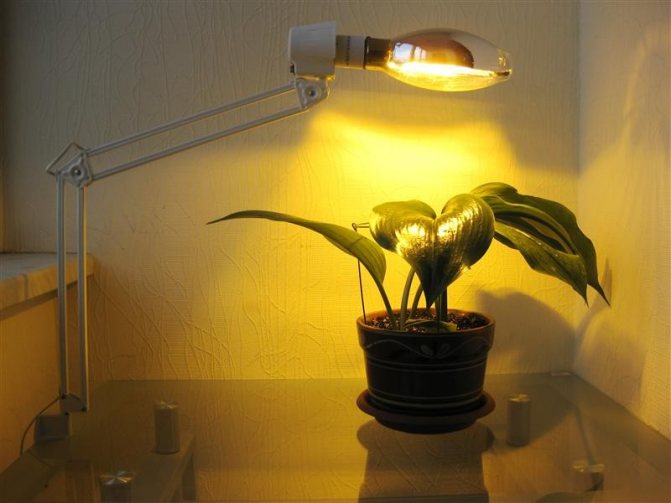

Why plants need lighting
Light is an important factor in the life of home flowers. It participates in the process of photosynthesis, when nutrients - carbohydrates and oxygen - are released from water and carbon dioxide. The process takes place in the leaves, which absorb carbon dioxide and sunlight. Carbohydrate compounds accumulate in the roots and feed the plant.
With the onset of darkness, the opposite process occurs - "night breathing", when oxygen is absorbed and carbon dioxide is released.
The lack of sunlight for home flowers leads to a reduction in the absorbed energy, the plant does not produce carbohydrates in the required amount, weakens, the stems become thinner and the leaves brighten.
Signs of insufficient light
The following external signs indicate a lack of light:
- Changing the natural color of leaves
- The lower leaves of indoor plants turn yellow and fall off. On young shoots, the leaves appear pale and smaller. The color of variegated plants loses its brightness, the drawing leaves, and they become just green
- Stems are stretched towards the light and bent
- The difference between the length of internodes in summer and winter can be 2-3 times
- New flower buds do not form, adult flowers fall off, and young buds are small and do not bloom
The need for lighting in indoor plants
The illumination of the room depends on the size of the windows and their position in relation to the sun. It changes with the appearance of cloudiness, depending on seasonality, daily time, the presence of shady trees and bushes outside the window. It is known that solar activity in the evening is much stronger than in the morning. Light for home flowers can be both a helper and a pest, so it is important to consider all the features.
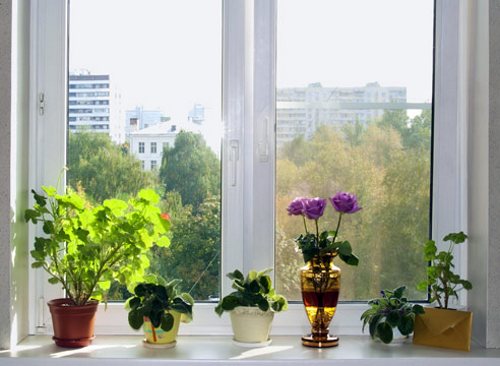

Daylight
The most illuminated place will be the room on the south side. The windowsill on the east and west sides are also illuminated.A place in a room at a distance of 1-2 m from the window, except for the north side, is considered partial shade. Near the north window, the place in the immediate vicinity will be penumbra. Shaded areas include zones at a distance of 2-3 m from the windows to the west and east, 3-4 m on the south side, at a distance of 1-2 m on the north.
Shade-tolerant species do not leave in the bright sun, the optimal distance will be 3 m on the west or east side. On short winter days, they are moved closer to the window.
Flowers, partial shade lovers, require a lot of ambient light. This category includes kokedama, zemnokulkas, alocasia. They also need cool air for normal growth. Medium lighting for indoor plants will provide placement by a window or on a windowsill from the east or northeast.
Houseplants that require bright lighting are shaded in the summer heat to prevent burns and drying out. To protect from direct sunlight, blinds are used that scatter light or move the flowerpot a meter from the window. The light arrangement for flowers will be in the west or southwest. In winter, they are transferred to the southern windowsill.
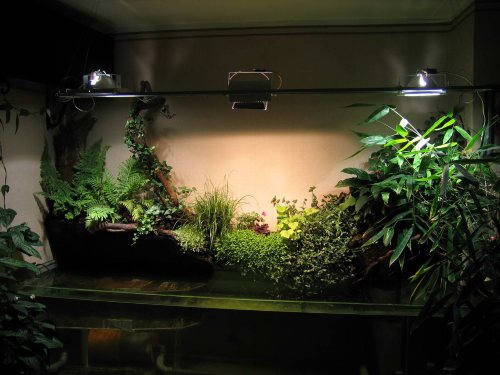

Artificial lighting
Indoor plants with their native land of origin in the desert, semi-desert and in the Mediterranean climate, are not afraid of sun exposure. For example, cacti and succulents can be placed on the south window.
Installation of fluorescent lamps
A pair of fluorescent lamps is fixed on a wooden block approximately 4 cm thick. On its upper surface, in an area inaccessible to moisture, an electronic ballast is fixed. According to the diagram indicated on it, lamps are connected by means of contact pads.
The lamps are carefully inserted into the clips previously fixed on the bar. It is advisable to equip the luminaire with a reflector. It is better to hang the device not on hinges, but on chains so that you can change the height of its location.
A store-bought timer can be connected to the luminaire so that the lighting mode is automatically adjusted.
Automatic light for seedlings.
The automation of the backlighting of seedlings consists in controlling the switching on and off of the power supply of lighting devices according to a given schedule. For these purposes, time relays are successfully used, which can be electromechanical, electronic with digital control, as well as with the ability to remotely control through various communication channels.
Several of these devices are available in our partner store. These devices are highly popular, reliable and inexpensive.
Smart wifi socket
Price on AliExpress: US $ 11.69 - 86.44
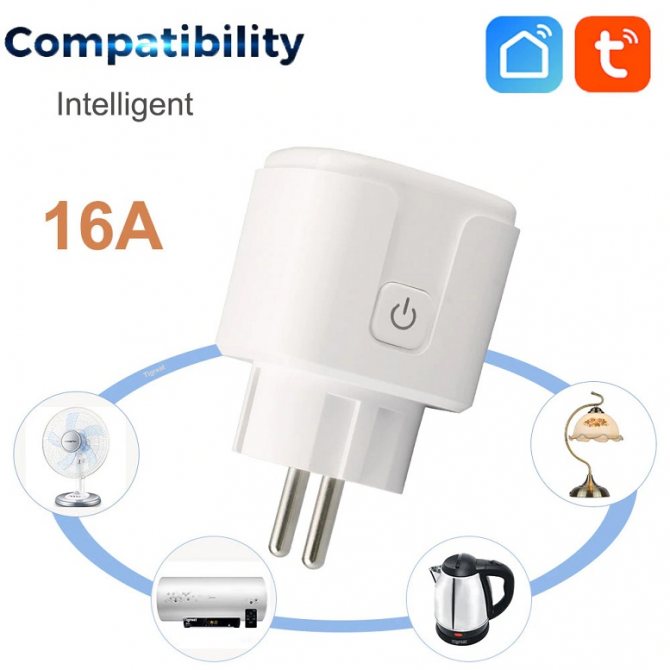

An excellent solution for controlling electrical appliances from a smartphone from anywhere in the world.
Price on AliExpress: US $ 11.69 - 86.44
Go to the store
Specifications:
- Socket type: EU smart wifi socket
- Input voltage: 110-240 V AC
- Frequency: 50/60 Hz
- Maximum current: 16A
- Maximum power: 3680 Wt
- Main material: abs + pc flame retardant material
- System support: Android 4.1 / iOS 8.0
- Standby power: 0.7 watts
- Network Security Level: WAP / WAP2
- Wi-Fi standard: 2.4GHz 802.11b / g / n
- Wi-Fi Distance: 50 meters outdoors, indoors up to 30 meters (Depends on building materials and structure)
- Working temperature: 0℃-40℃
- The size: 50 * 50 * 87mm
- Weight: 83 g
AHC15 AC 220V Din Rail Programmable Digital LCD Timer
Price on AliExpress: US $ 7.96
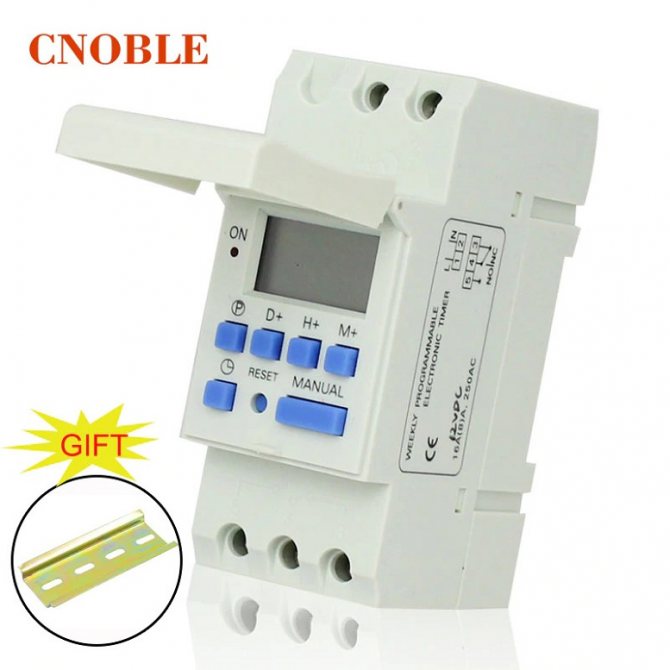

Multifunctional digital timer for controlling the switching on and off of electrical equipment according to a given schedule
Price on AliExpress: US $ 7.96
Go to the store
Characteristics:
- Frequency: 50/60 Hz
- ON / OFF mode: Automatic, manual, by days of the week, by timer - 16 incl. And 16 off.
- Power consumption: 7.5VA (max)
- Display: LCD display
- Minimum programmable time: 1 minute
- Maximum programmable time: 168 hours
- Maximum load: 30A / 250VAC
- Rated load: 10 A / 250 VAC
- User load: 2000 watts
- Switching contact: 1 switch
- Ambient temperature: -10- + 40 degrees Celsius
- Humidity of the environment: 35-85% RH
- The size: 8.6cm x 3.6cm x 6cm (LxWxH)
- Weight: about 115 g
- Working voltage: 12V, 24V, 110V, 220V for choice
Socket with mechanical timer 24 hours 230V AC 3500W 16A
Price on AliExpress: US $ 5.96
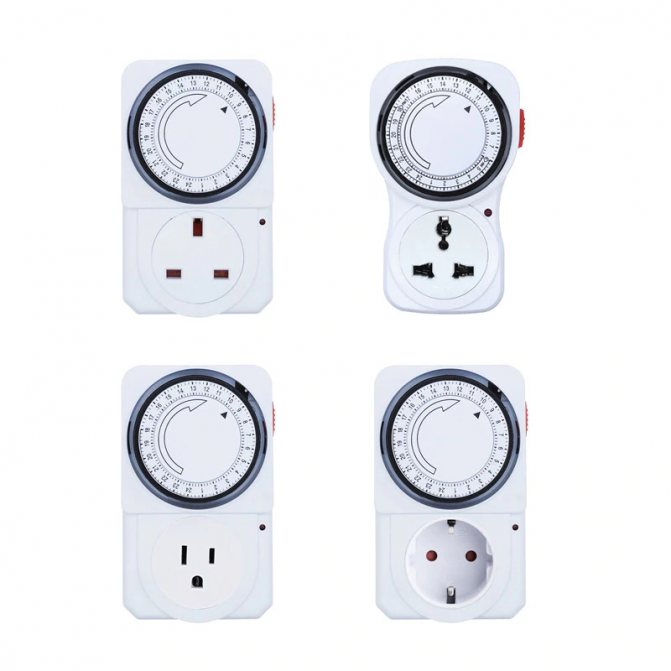

Reliable and inexpensive timer for controlling the operation of electrical appliances
Price on AliExpress: US $ 5.96
Go to the store
Characteristics:
- Frequency: 50 Hz
- ON / OFF mode: Automatic, manual.
- Display: Mechanical pointer
- Minimum programmable time: 1 hour
- Maximum programmable time: 24 hours
- Maximum load: 30A / 250VAC
- Rated load: 16 A / 250 VAC
- User load: 3500 Wt
- Switching contact: 1 switch
- Ambient temperature: -10- + 40 degrees Celsius
- Humidity of the environment: 35-85% RH
- The size: 12.1cm x 2.8cm x 7.1cm (LxWxH)
- Working voltage: 220 V
Ketotek electronic digital timer socket 230 V 50 Hz
Price on AliExpress: US $ 6.79 - 10.63
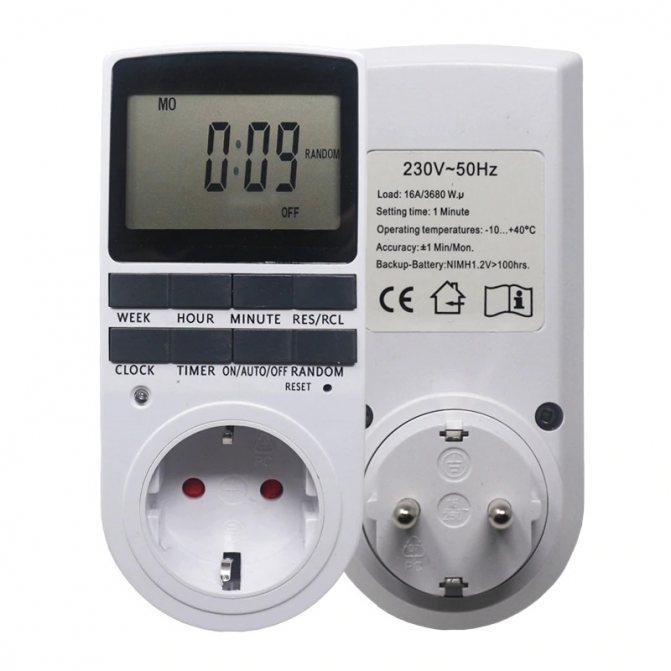

Programmable electronic digital timer 7 days 12/24 hours in the form of a transitional socket
Price on AliExpress: US $ 6.79 - 10.63
Go to the store
Characteristics:
- Dimensions (Approx.): 13cm x 5.8cm x 4.5cm / 5.12 "x 2.28" x 1.77 "
- Display: Large LCD display
- LCD Size (Approx.): 34 * 49mm
- Plug type: EU plug for choice
- Voltage: 230 V 50 Hz
- Installation: Plug-in Type: 230V-AC / 16A / 3680 W
- Installation time: 1 minute
- Working temperature: -10 ~ + 40 ° C
- Accuracy: 1 minute
- Battery: Nimh 1.2 V (battery built-in, non-removable)
- Life time: 100 hours
- Setting: Time setting includes hours, minutes and week
- Mode: Summer and winter time mode, Random function
- Certification: UL certified
Electric socket with programmable timer, 220 V
Price on AliExpress: US $ 7.83
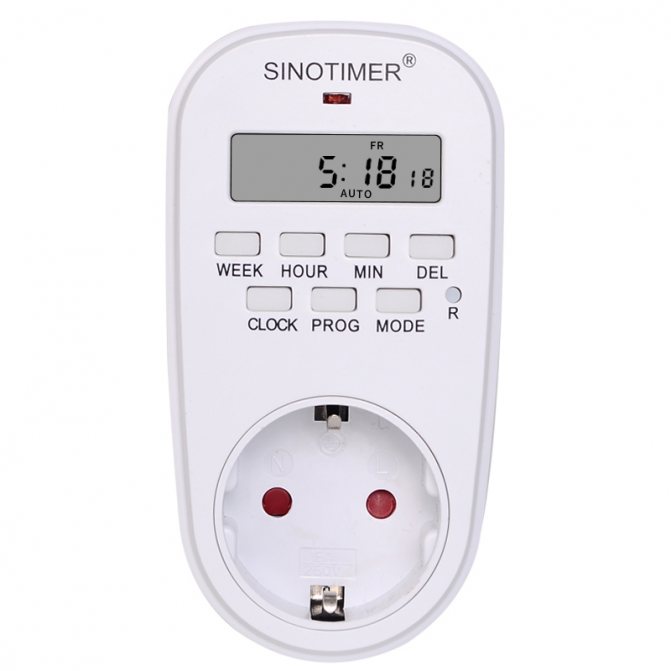

EU plug, digital time control 7 days a week, 230 VAC
Rules for the use of lamps
The ideal position of the lamps is considered to be on top of the plants. If the fixture is placed too high, illumination will not work, because illumination decreases in proportion to the distance.
Light-loving plants should be illuminated from a distance of 17-22 cm, if it is a fluorescent lamp.
The light bulb must always be placed on top of the plants because they are drawn towards the light, and what happens if the light shines from the side? The height needs to be adjusted - if burns are found on the leaves, then the lamp can be raised slightly.
If the stems are elongated, but their color has become paler, then the light source is too high and should be lowered. The minimum height of an incandescent light bulb from a bush should be at least 35 cm, fluorescent - 7 cm, sodium - 50 cm.
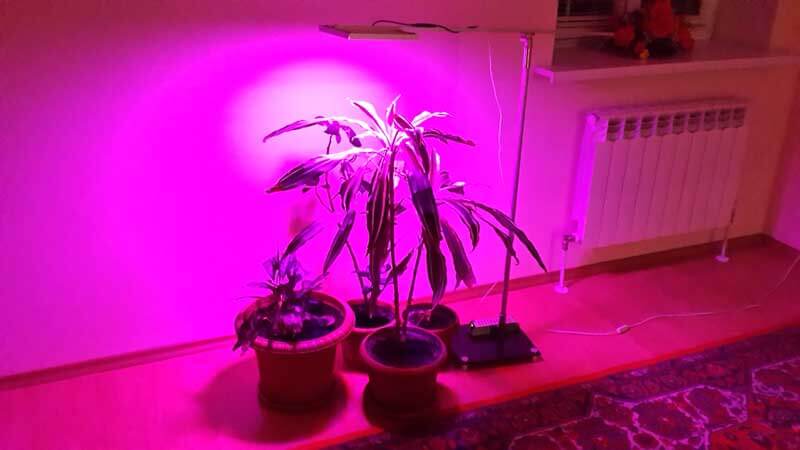

In addition to lamps, reflectors must be placed next to flowerpots and pots, the side of the reflector must be flush with the plant or slightly higher.
Do not use mirrors as reflectors, because they absorb light.
Provided that the plants are illuminated only with artificial light, then it must function for at least 12 hours. If it is used as an additional one, then 4-6 hours is enough. The lamp should be turned on 2 hours before dawn and 2-3 hours after dark.
If you have a huge greenhouse, then you need to install different types of lamps, then the flowers will definitely receive the radiation spectrum they require. When growing vegetable plants at home, it is required to have a sodium lamp to illuminate the seedlings and a luminescent lamp for the growth and development of grown sprouts.
LED bulbs
It should be said that the word "light bulb" does not quite match LED lamps. First of all, it is a solid-state semiconductor device that is absolutely safe to use, because there are no dangerous gases or mercury in the composition.
Light is generated by an electric current that passes through a crystal installed inside. All energy is spent on receiving light, which means that the device itself does not heat up, which is very important for flowers.
LED lighting for indoor plants is considered to be optimal in terms of its characteristics. First, the device can operate for several years if it is switched on continuously. Secondly, there is no infrared and ultraviolet radiation in the spectrum, which means that the lamp is safe for people and other living beings.
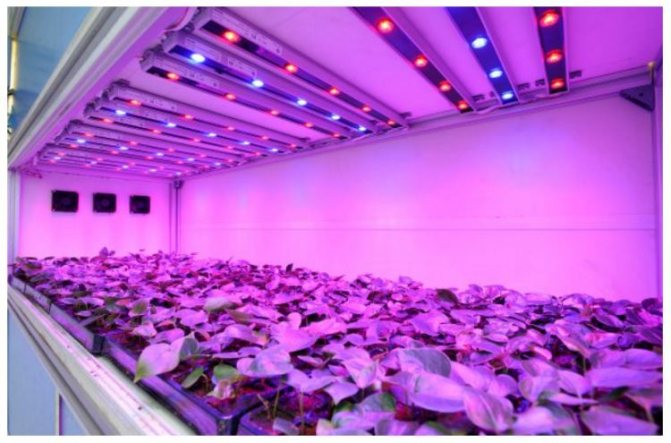

The color depends on the crystal placed inside the device. There are luminaires that contain several crystals, and they simultaneously provide several spectral colors. You can adjust the brightness of an individual LED by changing the amperage. LED devices are easy to install with your own hands; this does not require special knowledge and skills of an electrician.
The only drawback of LED lighting is the high cost of lamps. But this disadvantage is completely offset by the advantages of LED lamps.
Each grower decides for himself which type of additional lighting he should choose. Knowing the advantages and disadvantages of each type of lamp will help you make the right choice. Based on the information available at the moment, LED devices are considered the most optimal among plant breeders.
Application and what are they for
The main task of phytolamps is to stimulate plant photosynthesis when there is insufficient natural light. They are installed in winter gardens and greenhouses. In addition, phytolamps have the following advantages:
- They have an effect directly on the plant, without warming up or drying out the air.
- Thanks to the color action, the development of both horticultural and ornamental crops is improved.
- Help plants produce natural phytohormones that increase protective functions.
- If desired, the phytolamp can be assembled with your own hands.
- Resistant to high humidity, so they are great for greenhouses.
- Fireproof.
- Durable - most models last about 50 thousand hours.

